
What Is A Boat With 2 Masts Called?

Last Updated by
Daniel Wade
June 15, 2022
Two-mast sailboats hold special places in many sailors’ hearts. In addition to being dignified and majestic, a two-mast sailboat offers a perfect balance that can be easily achieved by adjusting the masts in many different ways. Let’s look at the different types of two-mast sailboats.
Whether you’re a sailboat fanatic or an interested observer, there’s something special about two-mast sailboats. In most cases, the first thing you’ll notice about a sailboat is the two masts. Generally, the mainmast is often taller than the aft-mast, which is often referred to as the mizzenmast. The mizzenmast is like a trusted old friend. It not only helps in stabilizing the sailboat under power but can also act as a bow thruster in certain scenarios. There are many reasons why sailors sing a lot of praises as far as two-mast sailboats are concerned. In heavier winds, you can break down the main mast and use the mizzen mast to give you a more balanced and comfortable sail even in the worst of conditions. But what is a boat with 2 masts called?
There are several sailboats with two masts. The most common ones include yawl, ketch, schooner, and brig. In most cases, the designs of the masts do vary but the main idea remains the same. They can have the extra mast either behind or in front of the mainmast. If the additional mast is in front of the mainmast, it’s known as a foremast but if the additional mast is behind (aft of) the mainmast, it’s known as a mizzenmast.
Let’s take a brief look at these two-mast sailboats.
Table of contents
A yawl is one of the most common types of two-mast sailboats. It has two masts: a mizzenmast and the mainmast. The mizzenmast is usually much shorter than the mainmast. This makes it an oblique type of a sailboat in the sense that the mainmast is located in the front of the boat while the mizzenmast is located in the rear past or the boat.
The mizzenmast of a yawl is mainly used to increase the helm balance and is located aft of or behind the rudder.
It’s always easy to confuse a yawl with a ketch so it would only make sense to clear up before going any further. They both have two masts with the mainmast at the front while the mizzenmast is smaller. The difference between a ketch and a yawl comes down to the location of the mast. In a yawl, the mizzenmast is behind the rudder post while in a ketch, the mizzenmast if in front of the rudder post.
Again, the mizzenmast of a ketch is nearly as tall as the mainmast and is used to carry a mainsail. Its main function, however, is to drive the sailboat forward and can sufficiently sail the boat, especially in heavier winds. This is very different from the mizzenmast of a yawl, which is only used to increase the helm balance and cannot drive the boat forward. This means that the mizzenmast of a ketch is bigger than the mizzenmast of a yawl. In short, the mizzenmast on a ketch is technically a driving sail while the mizzenmast on a yawl is more of a balancing sail.
A ketch generally has an advantage over a sloop in downwind or in heavy winds. This is because it has a variety of setups than a typical sloop. The mizzenmast gives you a lot of options to depower in heavy winds and find the most perfect amount of canvas to fly. It can also help in stabilizing the sailboat under the power given that the mizzenmast is naturally in an excellent position.
In essence, a ketch has many practical benefits that can be ideal in most situations in the waters. In addition to sailing peacefully on a beam-reach, a ketch is easily manageable and can give you a lot of options in various weather conditions and situations.
When it comes to a two-mast schooner (a schooner can have two or more masts), the foremast is usually smaller than the aft most mast, which is essentially the mainmast. As such, the main characteristic of a schooner is that the masts are almost of the same height but the foremost mast is slightly smaller.
Even though a schooner is easier to sail than say a sloop (one-mast sailboat), it isn’t very fast. This is why most sailors prefer a sloop to a schooner but it’s a sight to behold, especially when under full sail. While a schooner with a square topsail is the most common, there are others with sprit rigs that run diagonally. Schooners with spritsails are not ideal in big seaways because the sprit rig cannot be lowered since it could become unmanageable. On the other hand, the sprit rig is ideal in coastal waters given that the topsail can catch a high up breeze.
Like the above-mentioned two-mast sailboats, the brig has two masts with the foremost mast squared. The mainmast can be squared, partially squared or triangular. Some brig sailboats have a lateen mainsail on the mainmast. Historically, brigs were used by pirates and were set in motion using oars. Its name is derived from the Italian word “brigantine,” which loosely translates to “pirate.” These types of sailboats were used by pirates the Mediterranean in the 16th century before they became sailboats.

The two most common types of brigs are:
Brigantine – The foremost mast is usually partially squared but the mainmast is triangular.
Hermaphrodite brig – It’s also known as the schooner brig or the half brig. The two masts are partially squared but the mainmast is gaff-rigged and topsail, which technically makes it half schooner.
When it comes to speed and maneuverability, brigs are easy to handle and maneuver and perhaps that’s why they were preferred by pirates. Again, brigs are generally larger than other two-mast sailboats or single-mast sailboats.
There you have it; there are various types of two-mast sailboats, so there’s not a single name that fits all. You can choose any of them as they’ll serve you perfectly, especially in heavy wind conditions.
Bon Voyage!
Related Articles
I've personally had thousands of questions about sailing and sailboats over the years. As I learn and experience sailing, and the community, I share the answers that work and make sense to me, here on Life of Sailing.
by this author
Learn About Sailboats
Sailboat Parts
Most Recent

What Does "Sailing By The Lee" Mean?
October 3, 2023

The Best Sailing Schools And Programs: Reviews & Ratings
September 26, 2023
Important Legal Info
Lifeofsailing.com is a participant in the Amazon Services LLC Associates Program, an affiliate advertising program designed to provide a means for sites to earn advertising fees by advertising and linking to Amazon. This site also participates in other affiliate programs and is compensated for referring traffic and business to these companies.
Similar Posts

Affordable Sailboats You Can Build at Home
September 13, 2023

Best Small Sailboat Ornaments
September 12, 2023

Discover the Magic of Hydrofoil Sailboats
December 11, 2023
Popular Posts

Best Liveaboard Catamaran Sailboats
December 28, 2023

Can a Novice Sail Around the World?
Elizabeth O'Malley

4 Best Electric Outboard Motors

How Long Did It Take The Vikings To Sail To England?

10 Best Sailboat Brands (And Why)
December 20, 2023

7 Best Places To Liveaboard A Sailboat
Get the best sailing content.
Top Rated Posts
Lifeofsailing.com is a participant in the Amazon Services LLC Associates Program, an affiliate advertising program designed to provide a means for sites to earn advertising fees by advertising and linking to Amazon. This site also participates in other affiliate programs and is compensated for referring traffic and business to these companies. (866) 342-SAIL
© 2024 Life of Sailing Email: [email protected] Address: 11816 Inwood Rd #3024 Dallas, TX 75244 Disclaimer Privacy Policy

7 Popular Sailboats with Two Masts (With Pictures & Prices)
Sailboats can come with one, two, or even more masts. You can also have different-sized masts placed on the front, back, or middle of your vessel.
Below, I have listed popular sailboats that have two masts.
Let’s get started!
Table of Contents
Check also: Average sailboat price examples .
Things to Know About Sailboats With Two Masts
When looking for sailboats with two masts, you should know what you are looking for. A Ketch is one type of sailboat with two masts.
Knowing this term can help you to nail down your search when looking for a boat with two masts.
These boats come in many shapes and sizes as well as many different types of designs. Generally, these types of boats have the taller mast being forward and the smaller mast near the aft.
Yawls are also boats that feature two masts.
These also come in multiple types and designs. The difference between the Ketch and the Yawl is that the Yawl has the larger mast in the aft instead of forward. They also have smaller sails and can be easier to handle.
Another type of sailing ship that features two masts is a Brigantine.
This ship has mixed sailing rigs which commonly features squared sails on the front part of the ship and triangular sails on the back of the ship.
These boats are often larger and require more people to handle them.
7 Great Used Boats with Two Masts
There are many benefits to used boats including a lower cost. You can get a larger boat for a lower cost if you choose to buy used.
When looking at used boats, you need to make sure you look at the boat and its features thoroughly to make sure everything is in great working order.
If you do not feel confident that you can properly look over a used vessel, you can even hire a marine inspector to look it over and let you know of any potential issues or needed repairs. You can use this assessment to decide what is worth it, or if the needed repairs fall into the budget.
It is much more common for a used boat to have more than one mast. This is because the newer sailboat models are creating their new designs with just one mast.
One mast ships are easier to handle and manage so new designs are trying to optimize design and ease of sailing.
Below are great used sailboats with two masts which I have arranged by price .
1. 1976 Westerly Center Cockpit Ketch

This 1976 Westerly Center Cockpit Ketch is a small 36-foot long sailboat with two masts. This is a solidly built cruising vessel that features a center cockpit ketch layout.
This boat has a small 38 horsepower engine perfectly fit to navigate its smaller size.
The interior features 1 single berth and 3 double berths all in 3 cabins. This boat also has 2 full heads onboard.
You also have a full galley with a 4 burner stove, refrigerator and freezer, stainless steel sink, and microwave oven.
This boat makes great use of limited space and offers many amenities in a much smaller frame.
Price: $37,000.00
2. 1978 Jeanneau Gin Fizz

The 1978 Jeanneau Gin Fizz is a trusted and popular two-masted design capable of crossing the Atlantic Ocean .
This boat is also very spacious for a boat that is only 38 feet in length. This model also won an award for “security, comfort, ease of handling, and ability to handle varying conditions.”
This particular used model has been well maintained and upgraded over the years.
This boat is great for family cruising, offshore passages, and even racing.
This boat features a 50 horsepower engine to help navigation.
Inside you can find 2 cabins and 1 head. You will be highly comfortable with air conditioning and other interior luxuries.
Price: $46,000.00
3. 1979 Freedom 40
The Freedom 40 is a classically designed centerboard ketch with two masts. This boat is a great sailor loaded for cruising on the wide-open blue water.
This sailboat is 40 feet in length and features accommodations for six people that include a double-v berth, another double berth, and two single berths.
There is also a full head that can be accessed both from the main salon and aft cabin.
This boat was recently painted and features newer interior fabrics, forced air heating, and much more.
You can find a dinette with separate freezer and refrigeration compartments, a stove with an oven and broiler, a double stainless steel sink, plenty of storage, and other interior features.
This boat also comes with an outboard motor with 50 horsepower and a hard bottom inflatable dinghy.
Price: $54,900.00
4. 1977 Puma 38 Ketch

The Puma 38 Ketch is a two-masted sailboat built for racing like the rest of the Puma sailing line. This brand prides itself on speed and maneuverability.
The 1977 Puma 38 is 34 feet in length with a backup diesel engine that can help you get where you need to go as well as docking into a slip. This motor features more horsepower than the average sailboat with 45 horsepower.
Features on this vessel include autopilot, electrical and manual bilge pumps, a full marine head, running hot water, and refrigerator.
This boat is made of fiberglass with teak finishes and looks well kept. You can find this boat in Spain if you are interested in purchasing it.
Price: $66,099.00
5. 1973 Morgan Out Island 41
Originally designed by Charley Morgan, the Morgan Out Island 41 is a center cockpit shoal-draft cruiser that features two masts.
This larger boat is 41 feet 3 inches in length and features many amenities.
This boat is the tri-cabin version and features interior heating, pressurized hot and cold water, a 2 burner gas oven, and a fridge.
This boat also seats up to 7 in the 3 cabins and the saloon. There are also 2 full heads on this vessel.
This boat is even equipped with an inboard motor . Inboard motors are easier when it comes to navigation including backing up, which is generally hard for sailboats to do.
Price: $68,596.00
6. 1970 Hinckley Bermuda 40

This 1970 Hinckley Bermuda 40 is a gorgeous two-masted boat painted with a mixture of desert sand and oyster white on the exterior and features a beautiful and well-kept deck.
This boat has previously had all her systems replaced and upgraded and features a 40 horsepower engine that was new in 2014.
This boat features a mahogany interior and sleeps up to 6 people in 2 cabins. You can also find a 3 burner propane stove with oven, fridge and compressor, new countertops and plenty of storage.
This boat is a stunning and highly upgraded “must-see” at a very reasonable price.
Price: $129,500.00
7. 1995 Amel Super Maramu

A newer model of sailboat is the 1995 Amel Super Maramu sailboat. This sailboat has two masts and is very long at 53 feet.
This boat features an aft deck, steps molded right into the hull, well-protected cockpit an many other features. This boat has a large 76 horsepower engine which is more than the average sailboat is equipped with.
Inside, this boat features 2 cabins and 2 heads with showers. There is also plenty of storage, air conditioning , and electric heaters. There is also a nice salon and galley with a refrigerator, dishwasher, chest freezer, microwave oven, 3 burner stove, and other appliances.
This boat is great for multiple days out on the water and is new and updated. Because of the year, this was manufactured and the features, this boat has a larger price tag than the previous models.
Price: $299,990.00
Final Thoughts:
Sailboats are a great way to enjoy a day out at sea. Most sailboat models come with sleeping arrangements and even a kitchen. This makes them ideal for trips that will take more than a day.
Having multiple masts allows you to harness the power of the wind better and can increase your speed and directional capabilities.
There are many great choices when it comes to boats with two masts, but newer models are starting to steer away from double mast designs. This does not mean that you cannot get a good boat with two masts.
Used boats can be great choices when it comes to purchasing a boat. This is even more true with large, yacht boats such as the ones listed above.
Just make sure when you buy a used sailboat you check that everything is intact and in good working order and if it is not, you have allotted space in the budget to fix what is needed.
Your new double-masted sailboat should provide you with plenty of long-lasting memories and adventures out on the water while you connect with the wind and the sea.
Click to share...

What’s a Boat with Two Masts Called: Two masted sailing boat types
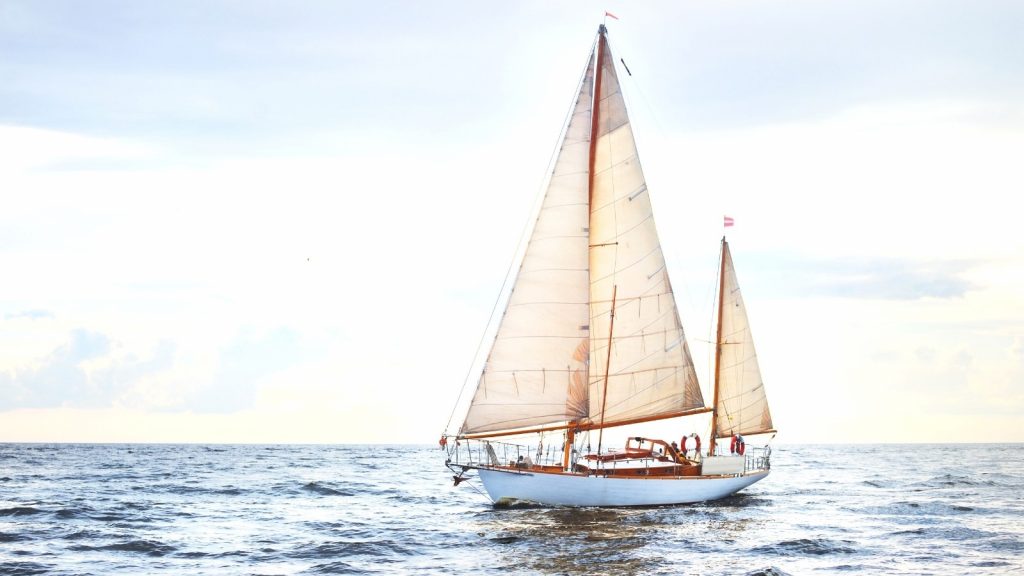
Two-masted sailing boats will always have a special place in the hearts of many sailors. Many sailors consider two-masted sailing boats to be the most attractive and graceful of all sailing vessels. They have an obvious elegance, but what do you know about these two masted sailboats? Let’s find out!
Among the most important aspects are the fact that two-masted sailing boats offer greater sail balance, engineless sailing and more heavy weather options.
Even if the two masted sailboats are not so common, the sailing world has a few of them and what is more, they represent a proof of the evolution and improvement of sailing boats over time. There are an almost endless number of ways sailors have arranged their sails on boats over the years.

Two-masted sailing boats are classified according to the size and position of their masts.
There are different two-masted sailing boat types and two of the most popular are schooners and yawls.
The origins of schooner-rigged vessels are unknown, however there is evidence of them in paintings by Dutch maritime painters dating back to the early 17th century.
Schooners were developed by Northern European countries, while yawls are believed to be descended from the fishing boats of England.
Sailboats with two masts include yawls, ketches, schooners and brigs (known as brigantines). Yawls and ketches are both types of sloops, which means they have one mast, but the difference between them is that the yawl has a second mast stepped at the bow.
Ketches and Yawls have a lower mast, unlike schooners that have a taller aft mast, which is also known as mizzen. Ketch sailing boats have something specific: the aft mast is located in front of the rudder post.
The yawl’s mizzenmast serves as a counterbalance for the jib sails, so that it doesn’t have to be hung from the forestay (the rope running from the top of the mast down to the deck). They’re usually smaller than ketches and have less rigging because they don’t carry as many sails as a sloop with two masts.
Yawls are faster sailboats than schooners because they’re lighter, more balanced and easier to sail upwind. They can also go faster because their shorter sails catch more wind. But schooners have larger payloads, which means more people or cargo — an important consideration for long trips without resupply.

Schooners are two-masted sailing boats, but instead of having a jib sail like yawls, ketches and most sloops, schooners have a fore-and-aft spanker sail like a gaff sailboat. These two-masted sailboats have at least two masts, the foremast being slightly shorter than the main mast.
Schooners are larger than yawls, ketches and other sloops and weren’t used very much in modern times because they were more difficult to handle. They’re still used in racing competitions today.
Schooners have a longer bow portion than yawls. The mainsail is aft of the mast, and either one or two foresails are in front of it. In a schooner, these are triangular sails; in a yawl, they’re trapezoidal. Yawls have bowsprits — poles that extend beyond the bow for the jib and stay sail to be attached. Schooners have small bowsprits that can support jibs but not large sails.

The term ketch derives from the word catch, which hints to how it got its name in the 17th century. Ketches were initially intended to meet the specific requirements of offshore net fishing.
Ketch is a type of sailboat that features two masts and two sails, commonly used as a racing and cruising boat. The mainmast of this two-masted sailboat is typically taller than the mizzen mast (aft-mast). Its name derives from catch.
Taller masts allow you to use larger sails, so ketch boats are able to achieve better speeds than similar boats with only one mast. Some ketch designs feature a gaff rig, which is similar to a yawl, while others feature a yawl rig, which looks like a traditional sloop.
Ketch boats may look easy to sail but the slightest mistake can lead to disaster. You must be careful when operating this type of boat because it does not have as much stability as other boats, especially when you’re manoeuvring in tight quarters or windy conditions.
A ketch may also be a small recreational boat with only one head-sail in use. Many modern designs have moved away from sail altogether and are powered by engine, while others use both sails as well as engines depending on circumstance.

The brigantine was once a tiny ship that carried both oars and sails. It was a favorite of Mediterranean pirates.
A brigantine is a square-rigged sailing boat with two masts, with a fully square-rigged foremast and two sails on the mainmast.
The mainmast is stepped forward of the deck, making it possible to sail into the wind using a triangular headsail known as a jib. The brig’s foremast is shorter than the mainmast.
The name of this type of boat with 2 masts is derived from the Italian word “brigantino”, which means brigand.
Also, this two-masted sailing boat type was most commonly used for coastal trade and pirate hunting. The brigantine had an advantage over other ships of the time because it could sail against the wind using both sails, making it easier to travel against strong winds.
Faster and easier to manoeuvre than a sloop or schooner, it was used for piracy and espionage.

FAQ: Two-Masted Sailboats
What do you call a two-masted sailboat.
Two-masted sailboats are of several types: yawls, schooners, ketches or brigantines.
Why do some sailboats have two masts?
The vast majority of sailboats feature a mainsail and a jib. These two-masted sailboats provide several advantages in terms of speed and maneuverability. These two masts may be configured in a variety of ways.
The foresail directs air beyond the back of the mainsail, generating greater power from the wind. In order to help menouvering, the foresail can be backed. So, adding sails makes things simpler for bigger boats, making them easier to handle in heavy winds.
What is the difference between a ketch and a yawl sailboat?
Because they are lighter, more balanced, and easier to sail upwind, yawls are faster sailboats than schooners. They can also go at a faster speed since their shorter sails collect more wind. Schooners, on the other hand, have higher cargoes, which means more people or freight – a crucial consideration for extended journeys without replenishing.
What is a one masted sailboat?
It's a sailing boat having a single mast roughly one-third the length's aft of the bow. A sailboat with a single mast usually has one headsail in front of the mast and one mainsail behind the mast.
What is a two-masted square rigger?
It's a brig with two square-rigged masts. A gaff-rigged fore-and-aft sail also called a "mizzen" is used in addition to jibs and staysails (stays'ls) before the foremast and staysails between the masts.
Leave a Comment Cancel Reply
Your email address will not be published. Required fields are marked *
- The Enchanting World of Two-Masted Sailing Ships: A Comprehensive Guide
Two-masted sailboats, with their elegant profiles slicing through the waves, serve as a bridge between the past and present, combining traditional sailing heritage with contemporary performance. These vessels, marked by their dual masts—the foremast and the mainmast—embody a blend of artistry and engineering, appealing to a wide array of sailing enthusiasts.
History and Evolution: From Ancient Origins to Technological Advancements
The lineage of two-masted sailboats stretches back to ancient maritime civilizations, where the imperative of ocean exploration spurred the development of advanced sailing technologies. These early innovations laid the groundwork for the evolution of sailboats, which adapted over the centuries to meet the changing demands of navigation, trade, and warfare. The design and functionality of two-masted sailboats have been refined through technological advancements, making them as much a symbol of historical progress as they are of nautical tradition.
Design and Features: Anatomy and Types of Two-Masted Sailboats
Understanding the design of a two-masted sailboat is key to appreciating its capabilities. The complex arrangement of hull, masts, sails, rigging, and keel is essential for the boat's performance at sea. These components work in harmony to harness the power of the wind, enabling the vessel to navigate with precision and grace. The variety within this category, including schooners, ketches, yawls, and brigs, highlights the adaptability of two-masted sailboats to different sailing needs, from leisurely coastal cruising to high-stakes ocean racing.
Read our top notch articles on topics such as sailing, sailing tips and destinations in our Magazine .
Check out our latest sailing content:
Where to shelter from the Bora in Croatia?
What skipper's licence do I need?
From Lefkada or Corfu to Paxos and Antipaxos
Discover the paradise of Paxos and Antipaxoss
Discover Corfu: sailing adventure in the Ionian
Sextant and navigation: survival without GPS
5 best sailing routes in the Bahamas
Yachting guide to the Bahamas
The ultimate yacht cleaning kit
Traditional sailor tattoos: Meaning of the swallow
The most popular catamarans of 2023
Fishing and sailing: where to sail for the best catches?
Lighthouses you won't forget
New Year's resolution: let's sail more eco
British Virgin Islands: sailing paradise
How to get kids to enjoy sailing?
How to sail a yacht on a tailwind
How to sail a yacht in crosswinds
Götheborg: the greatest sailing ship
How to have a nautical Christmas
What to pack for a tropical sailing
How to sail a yacht against the wind
Sailing the Maldives: paradise
Interview: is ocean pollution irreversible?
How to gear up for the 2024 sailing season
Medicanes in Greece
Top 10 reasons boaters contact their insurers
New boats for rent in 2024
Currents and sailing: the Atlantic Ocean
Trade routes that shaped the world
Two-Masted Sailboats in Use Today: Recreational and Competitive Sailing
Today, two-masted sailboats flourish in both recreational and competitive arenas. For leisure sailors, these vessels offer a unique combination of challenge and tranquility, allowing for intimate experiences with the sea. The versatility of two-masted sailboats makes them ideal for a range of activities, from day sailing to extended voyages. In the competitive realm, these sailboats demonstrate their enduring relevance and performance, participating in regattas and races that test the skill and strategy of their crews.
Maintenance and Upkeep: Ensuring Longevity and Performance
The beauty and functionality of two-masted sailboats are preserved through meticulous maintenance and thoughtful care. Routine inspections and maintenance tasks are crucial for keeping these vessels seaworthy, highlighting the importance of attention to detail in preserving their condition. Beyond the immediate upkeep, long-term care strategies are essential for ensuring that these iconic vessels continue to grace the world's waterways, serving as living links to the rich maritime heritage they embody.
Famous Two-Masted Ships: Icons of the Seas
Throughout history, several two-masted ships have etched their names into the annals of nautical lore, becoming icons of exploration, power, and adventure. Ships like the HMS Beagle, renowned for carrying Charles Darwin on his epic voyage that contributed to the development of evolutionary theory, and the schooner Bluenose, a racing legend and fishing vessel that symbolized Canadian grit and maritime prowess, are prime examples. These famous ships not only highlight the critical role of two-masted vessels in exploration and competition but also celebrate their timeless beauty and enduring spirit.
In essence, two-masted sailboats encapsulate the spirit of sailing, merging the allure of history with the thrill of modern-day navigation. They stand as a testament to human creativity and the ceaseless quest for harmony with the elements, inviting each new generation of sailors to partake in a journey that transcends time and tides.
So what are you waiting for? Take a look at our range of charter boats and head to some of our favourite sailing destinations.
Interested in exploring the world of two-masted sailing ships? Contact me to book your yacht experience today!

Denisa Nguyenová
Understanding the Two-Masted Sailboat
By Matt Claiborne
Two-Masted Boats with Fore-and-Aft Rigged Sails
A ketch is a two-masted sailboat. The rear mast, called the mizzen mast, is shorter than the forward main mast. The mizzen mast is mounted forward of the rudder post.
A yawl is similar to a ketch, but the rear mizzen mast is moved farther aft, behind the rudder post. This makes the mizzen on a yawl seem like an afterthought, almost like it’s attached to the railing.
If a two mast boat has masts of equal height or the forward mast is the shorter of the two, it is a schooner. They can have as many masts as the design called for.
Benefits of Two Masted Sailboats
Easy to balance steering forces
More sail plan options for heavy winds
Lower sheet loads mean smaller and less expensive
Lighter loads on smaller sails for easier handling
Shorter overall mast height for bridge clearance
Mizzen can be used as a riding sail at anchor
2 Masted Ship Examples with Square Rigged Sails
A brig is a double mast sailboat with both masts square rigged. In addition, it has fore-and-aft staysails and jibs and a mizzen sail on the aft mast–which is usually gaff-rigged.
A brigantine is a ship with two masts, with the foremast square-rigged and the aft mainmast fore-and-aft rigged.
The Two-Masted Sailboat
Boat maintenance.

- Find A School
- Certifications
- North U Sail Trim
- Inside Sailing with Peter Isler
- Docking Made Easy
- Study Quizzes
- Bite-sized Lessons
- Fun Quizzes
- Sailing Challenge

What Type of Sailboat is This?
By: Zeke Quezada, ASA Equipment , Sailboats
While sailing in the Sir Francis Drake Channel in the British Virgin Islands I noticed a peculiar catamaran heading in our direction. A two-masted catamaran. Have you seen a boat like this? Does it have a name?
How often do you see a sailboat and realize that it has a different sail plan or configuration and most likely has a different name?
This guide to sailboats should help you identify the types of sailboats you might encounter while on your cruising adventures.
You’ll be able to find even more info on these different type of sailboats in our series “What’s in a Rig.”
What type of a boat is this…?

A sloop rig is a boat with a single mast and a fore and aft sail configuration. Sloops date back to the early 17th century but didn’t really become popular until the 20th century. The likely reason for their popularity is their ability to efficiently head upwind and how relatively simple they are to control – great for short-handing.
Cutter Rig:

A variation on the Sloop is the Cutter Rig. Although it has gone through some changes through the course of history, the modern cutter rig is generally a set-up with two headsails. The forward sail is called the Yankee, and the one slightly behind it is the staysail.

There are many who feel that this very old but very innovative sail plan is superior to the more popular and ubiquitous sloop rig and others. The junk is predicated upon fully battened sails, a characteristic associated with more modern racing vessels, and they typically lack any standing rigging (stays and shrouds). Due to the full batten set-up, the sails maintain an efficient, consistent shape and are fast, especially downwind. In a big breeze, junk owners will attest that they’re extremely easy to reef and, as an added bonus, are inherently self-tacking.

They are two masted rigs with a main mast and a (smaller) mizzenmast that is set in front of the rudder post – they carry a jib just like a sloop. Generally, ketches will be in the 40-plus foot range. The reasoning for this is that before sailing hardware was as advanced as it is now, designers were looking for ways to carry a good amount of sail but make it manageable at the same time. This configuration served that purpose and, while doing so, also gave sailors quite a few options for various weather conditions and situations.

Like, the ketch, a yawl is equipped with two masts, a main and a mizzen, but ordinarily, on a yawl, the mast is smaller and set behind the rudder post. While some yawl sailors contest the small sail configuration that hangs over the stern as an aid to heaving to and steadying life at a mooring, most concede the mizzen on a yawl is not what it is on a ketch. Typically, it doesn’t provide any horsepower to speak of or ease-of-handling benefits in splitting the rig like a ketch or schooner might.

A gaff rig employs a spar on the top of the sail, and typically other sails can be set in conjunction with that mainsail with the gaff. Often, on the smaller, non-tall ship, gaff rigs, there will be a small triangular sail that fits between the main and the mast like a puzzle piece – this is the topsail.
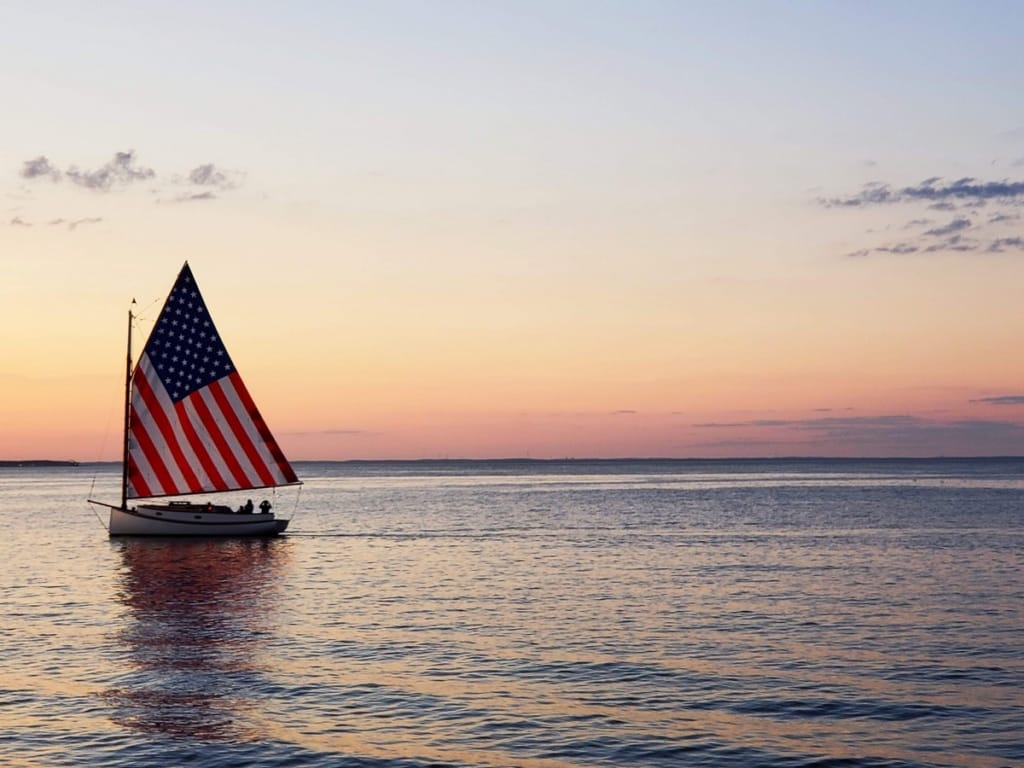
A cat rig is a single mast situated well forward, near the bow, which carries a large single sail and has no standing rigging, sometimes referred to as “unstayed.” An Optimist, Laser or Sabot are common (smaller) examples of a cat rig, but many bigger boats utilize the set-up.

A schooner is a sailboat with at least two masts, with the forward mast (foremast) being a bit shorter than the main mast. Although a schooner can have more than two masts, most were just two. During the time of their popularity, this smaller and better upwind setup allowed for a more efficient and manageable sailboat. It was the preferred choice of pirates, privateers, slaveship captains and others.
So what type of boat is this? Let us know. Find us on Social media and share your thoughts @AmericanSailing

Related Posts:

- Learn To Sail
- Mobile Apps
- Online Courses
- Upcoming Courses
- Sailor Resources
- ASA Log Book
- Bite Sized Lessons
- Knots Made Easy
- Catamaran Challenge
- Sailing Vacations
- Sailing Cruises
- Charter Resources
- International Proficiency Certificate
- Find A Charter
- All Articles
- Sailing Tips
- Sailing Terms
- Destinations
- Environmental
- Initiatives
- Instructor Resources
- Become An Instructor
- Become An ASA School
- Member / Instructor Login
- Affiliate Login
What Is A Boat With 2 Masts Called?
Sailboats have held and air of mystique and romance ever since the early explores sailed the globe.
However, the early trade ships were somewhat restricted in their ability to sail into, or against, the wind. As a result, the ships that discovered the new world were slaves to the directions the trade winds were blowing.
Today, thanks to advances in hull design, sail orientation and mast placement, there are numerous sailboat designs that use multiple sail configurations that can travel around the world in any direction at any time of year.
Over the years the types of sailboats have been reduced to a few well-performing designs. These designs are divided into the two main classifications of one-masted boats and those with two or more masts with each mast being capable of supporting one or more sails.

The sloop is the most common type of sailboat and has just one mast, placed roughly at midship, with up to three headsails attached to the mast by guy lines. Boats with 2 masts or more are the ketch, yawl, brigantine, brig and the schooner , with the schooners having two, three, or in rare cases, four masts.
Many sailors like the ketch-rigged design for its off-shore performance, comfort and overall balance. This design has a main and mizzen sail, with the mainsail set in approximately the same position as on a sloop, The mizzen is a smaller mast sail set towards the rear of the boat.
The concept behind the two-sail setup on the ketch-rigged sailboat is that it provides two smaller sails that provide more overall sail area than the single sail design.

In theory the smaller sails are easier to work with in heavy off-shore winds, making the boat much easier to sail in storms. Because of the smaller and easier-to-handle sails, the design is a good choice for long distance short-handed sailing.
The mizzen sail also acts as sort of a “rudder” in helping to keep the boat sailing in the proper direction because of the downward force the mizzen applies to the rear of the boat.
Comfort is another strong selling point of this design. Whereas most sailboats are designed with the cockpit at the stern of the boat, this sailboat has a center cockpit design to allow for the placement of the mizzen sail aft.
Having the cockpit in the middle of the boat allows for more headroom below deck at the rear of the boat and a larger aft cabin. Additionally, unlike an aft cockpit that usually has the rear open to the ocean, a center cockpit is fully enclosed. This offers protection from the elements while at sea and makes for a much nicer sitting area.
The ketch-rigged sailboat is a time-proven rig that has made untold circumnavigations of the globe. For sailors who like the two-mast design, this sailboat is a hard choice to beat.
The yawl is also equipped with a main and a mizzen mast. However, a yawl typically has a smaller mizzen with the mast set aft of the rudder post.
There are as many arguments about whether the yawl is a practical off-shore design as there are species of fish in the ocean. While there are some that site the sail plan of the yawl as more aesthetic than functional, there are many long-time professional sailors who swear by the yawl design.
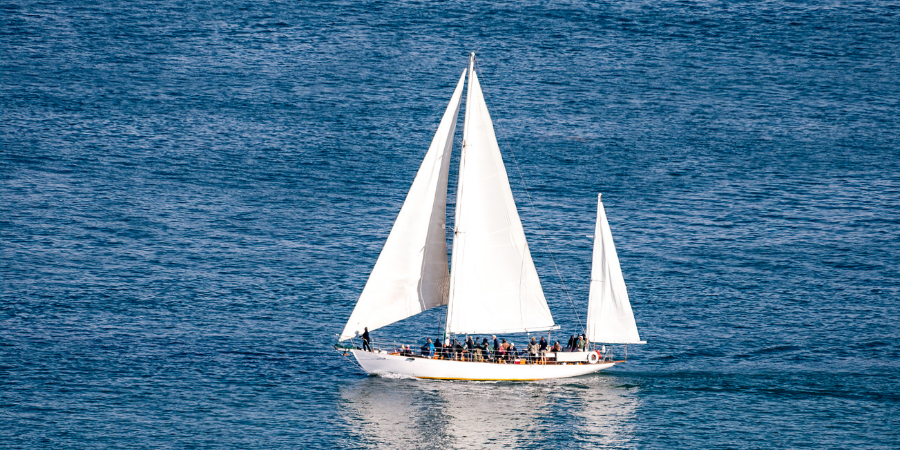
In theory, at least, the rear mast works as a rudder similarly to the ketch-rigged sailboat. The arguments typically start over the size and placement of the mizzen mast.
Some claim that placing the mizzen further back aids in helping to steer the boat. The other side of the argument is the reduced sail size makes it less efficient.
There is also the point that some sailors feel the mizzen being placed further back aids in heaving, or changing direction, and helps with steadying the boat at anchor.
Still, most sailors familiar with both the ketch and yawl say that the mizzen on the yawl is not a match for that of the ketch-rigged sailboat.
Brigantine and the Brig
Of similar, but not identical design, the brigantine and brig fall into the category of “clipper” or merchant ships.

Both are two-masted boats with the brigantine having square sails on the foremost mast and gaff sails on the mainmast. Here note that the smaller foremast is set forward of mast for the main sail.
Gaff sails are a four-cornered sail design attached to horizontal pole that hangs from the mast. Because of the smaller design, gaffs sails are more easily handled. In contrast, the brig uses square sails on both masts.
Both ships handle both coastal waters and ocean crossings as the square sails are well suited for sailing the trade wind routes.
A schooner is another boat with 2 masts, but can also have more. Like the brig and brigantine, a two-masted schooner has a foremast and an aft mast, the latter essentially being the mainmast.
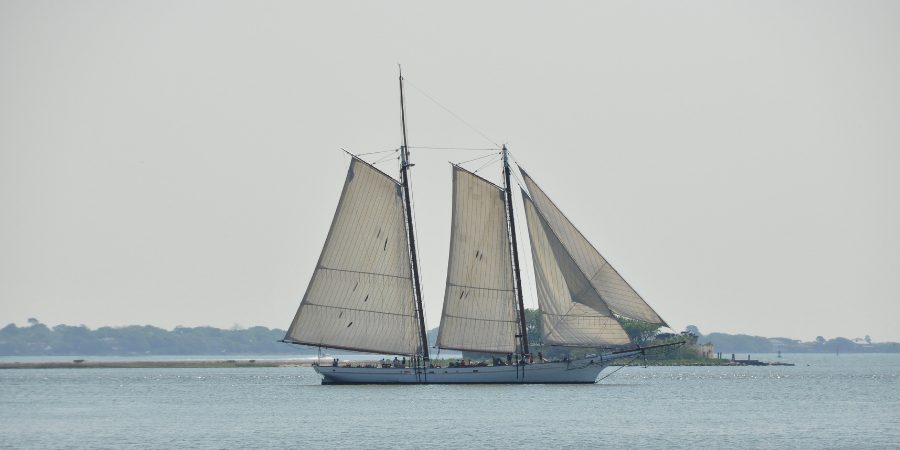
The main characteristic of the schooner is the masts are almost the same size, with the foremost mast sometimes being slightly shorter. The schooner is equipped with gaff sails on all masts, making it better equipped to handle strong seas.
This makes the schooner very versatile and well suited to crossing the ocean on the trade-wind routes as well as sailing coastal waters with varying wind directions.
Closing Thoughts
Because of the versatile design, many pleasure sailboats during the 19th century were schooner-rigged.
While a square topsail is the most common schooner sail plan, some have sprit rigged topsails that run diagonally across the mast. However, sprit rigging is inefficient in adverse weather as the sails are not easily lowered.
Conversely, sprit rigging excels in coastal waters where the sails can more readily catch the light winds that tend to blow higher up.
While a schooner is easy to sail, can handle various wind and water conditions and is probably the most magnificent sight on the sea under full sail, the draw back of the schooner is it is definitely not the fastest sailboat design.

Two-Mast Sailboat Types
Numerous sailors have a soft spot for two-mast sailboats, and there really is something unique in two-mast sails, irrespective of whether you are a sailboat enthusiast or just an intrigued passerby.
The two masts are typically the first feature you observe on such a sailboat. The mainmast, or foremast will usually be larger than the rear mast, also known as the mizzenmast.
But aside from being elegant and impressive, a two-mast sailboat provides perfect balance, which can be best obtained by making adjustments to the masts in a variety of ways.
The mizzenmast acts as that shoulder you can rely on as it assists with the sailboat’s stability while it is moving, and it can also function as a propulsion system in certain situations.
So, let’s take a look below at various kinds of two-mast sailboats and their advantages!

What Do You Call A Sailboat With Two Masts?
Several sailboats have two masts (see also ‘ Sailboat Mast: Everything You Need To Know ‘), the four most popular of which we will explore in a bit. In these sailboats, the styles of their masts differ in most instances, but the basic concept stays the same.
All these sailboats come with an extra mast at the rear or the front of the foremast. If that supplemental mast is in front of the foremast, it is called a foremast; if it is behind it, it is called a mizzenmast.
Among the most popular two-mast sailing vessels is the yawl. It is equipped with a mizzenmast and a foremast. Typically, the mizzenmast will be relatively short, particularly when compared to the foremast.
This renders it an angled sailboat, seeing that the foremast is situated at the front of the boat and the mizzenmast is situated at the back. A yawl’s mizzenmast is situated toward the back of the boat steering mechanism and is primarily used to boost helm stability.
It’s very easy to mix up a yawl and a ketch, so it’s best to clear that up before proceeding. They both are two-mast sailboats, with the foremast at the front and the mizzenmast behind it.
The spot of the mast is what distinguishes a ketch from a yawl. The mizzenmast is placed behind the boat steering mechanism post in a yawl and in front of it in a ketch.
A ketch’s mizzenmast is approximately the same height as the foremast, and it is employed to hold the mainsail. Its primary purpose, though, is to propel the boat as well as sail it adequately, especially in stronger wind.
That very function contrasts with a yawl’s mizzenmast, which is only utilized to help with balancing the steering wheel and cannot propel the boat forward.
This indicates that a ketch’s mizzenmast is larger than a yawl’s mizzenmast. In summary, a ketch’s mizzenmast is a moving sail, whereas a yawl’s mizzenmast serves as a balancing one.
In downwind or wind gusts, a ketch is at a favorable position when compared to a sloop. This is due to the fact that it has more setup options than a standard sloop.
The rear mast allows the sailor to adjust in strong winds and choose the most appropriate percentage of canvas to move with.
Provided that the mizzenmast is typically in an ideal position, it may also aid in the stabilization of the sailboat under force.
Essentially, a ketch comes with numerous practical advantages that make it ideal for most scenarios on the water.
A ketch, other than cruising serenely on a beam reach, is completely controllable and can provide a wide range of possibilities in a variety of weather circumstances and situations.
A schooner can even have three masts, but the one with two typically has a fairly small mainmast and a bigger mizzenmast, which in essence becomes the mainmast.
As a result, the main feature of a schooner is that its masts are both tall and with little to no difference, with the rear mast, in some cases, being a bit taller.
A schooner is slower than a sloop, despite being simpler to navigate. That is why so many seafarers choose to sail with a sloop than with a schooner, although it’s still an impressive sight, and even more so when fully sailing.
Even though schooners with square-shaped sail is what most people often get, several other schooners available are equipped with diagonal sprit rigs.
Schooners that have spritsails are unsuitable for large sea routes as, when the sprit rig gets lowered, it becomes impossible to manage. The sprit rig, on the contrary, is perfect in coastal areas because the topsail can hold a high gust of wind.
The brig, same as all the previously mentioned sailing ships, is a two-mast sailboat, with the foremast being of a square shape.
The foremast may come in the shape of a square, part square, or triangle in design. The foremast of certain brigs has a lateen mainsail (see also ‘ The Definition And History Of The Lateen (Triangular) Sail ‘).
These sailboats have been heretofore employed by pirates and launched by oars. Its name originates from the Italian term “brigantine,” which roughly translates to “pirate.” Before becoming sailboats, such kinds of sailboats were employed by pirates in the 1500s.
The two most prevalent brig varieties are:
- Brigantine – The main mast is triangular, while the front mast is partly squared.
- Hermaphrodite brig – This brig is equipped with two slightly squared masts, with the mainmast being gaff-rigged and topsail, something that makes it a half schooner. That is why it is also referred to as the schooner brig or the half brig.
Brigs are simple to operate and navigate in terms of speed and drivability, which may be why pirates favored them, and they are usually bigger than the rest of the two-mast or single-mast sailboats.
The Benefits Of A Two-Masted Sailboat
But why might someone prefer a two-masted sailboat more than a single-masted one?
At first glance, perhaps it will look like a one-masted sloop is easier to control. However, having more masts and a wider range of sails to pick from has its benefits.

A Two-Masted Sailboat Has Greater Sail Area Division
When a sail area is split over a larger number of sails, the area for every sail becomes smaller and easier to navigate.
This is especially useful when moving with fewer passengers on board and in strong weather conditions.
A Two-Masted Sailboat Provides More Rough Weather Choices
If a cruiser encounters higher-than-expected winds, having more sails, and thus more alternatives, can be extremely beneficial.
Most ketch-rigged boats, for instance, can rest nicely in rising winds and waves with only the mizzen being used to hold the boat’s bow facing up into the wind, a practice called “heaving to.”
This tends to mean that the staff does not have to be on deck and can remain safely hidden below since the sail works on its own.
A Two-Masted Sailboat Provides More Sail Balance
Seafarers must be knowledgeable of sail balance if they want to maneuver a boat proficiently.
This entails ensuring that the sails are drawn in such a way that the sailboat can float in a horizontal line without having to utilize the rudder excessively in order to right the route.
A Two-Masted Sailboat Allows For Engine-Free Sailing
If you want the enjoyment of cruising without relying on an engine, or if your engine won’t work, knowing that you have a mizzen sail could be extremely advantageous.
The mizzen can be employed to float smoothly and in perfect control when trying to catch or deciding to leave a mooring ball.
The same is true for anchoring while sailing. This is definitely not an uncommon case scenario; we have all had to do something similar at least once in our lives.
A Two-Masted Sailboat Provides An Anchor Riding Sail
Even as you are sailing across the globe, you will inevitably come across an anchorage that is just not perfectly easy and serene.
The smallest wave that can create some kind of shuddering can make people onboard feel nervous and become dissatisfied with their sailing experience.
A two-mast sailboat will be in an advantageous position in this situation as the mizzen can be lifted and fastened in firmly to counteract the boat’s side-to-side moving.
It may also be counterbalanced by attempting to make use of the wind to direct the boat’s bow into the waves, resulting in a way steadier sailboat and a satisfied crew.
A Two-Masted Sailboat Is Nearly Impossible To Be Completely Dismasted
A two-masted sailboat has an extra benefit: the mizzen, while too small to push the sailboat at high speeds, can most likely get you back safe in case the mainmast breaks or is torn apart in extreme situations.
The Bottom Line
There are dozens of reasons why seafarers chant paeans to these sailboats. Even in windy conditions, you can break down the mainmast and employ the mizzen mast to provide a more aligned and pleasant voyage.
There are different kinds of two-mast sailboats, thus there is no single term that can fit them all.
The only thing that can group them is their two-mast feature, so if you decide to sail in one of them, it is up to your preference to choose which one will take you on your next adventure!
Related Posts:
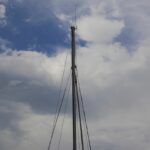
The 15 Different Types Of Sailing Ships
The 15 types of sailing ships are listed below.
- The Schooner
- The Carrack
- The Brigantine
- The Barquentine
- The Clipper
- The Windjammer
- The Fully Rigged Ship
Throughout centuries, there have been many different types of sailing ships seen from harbors and coastlines around the world.
This article will show the various types of sailing vessels that have made their mark in maritime history and we showcase their purposes and why they are still remarkable feats of marine engineering.
The different sizes, shapes, and masts of the ships required different numbers of sailors to handle them and each type of ship was crafted with a different purpose in mind.
All ships are unique with no two types of ships being the same with each coming with its own experiences, features and requirements.
1. The Schooner
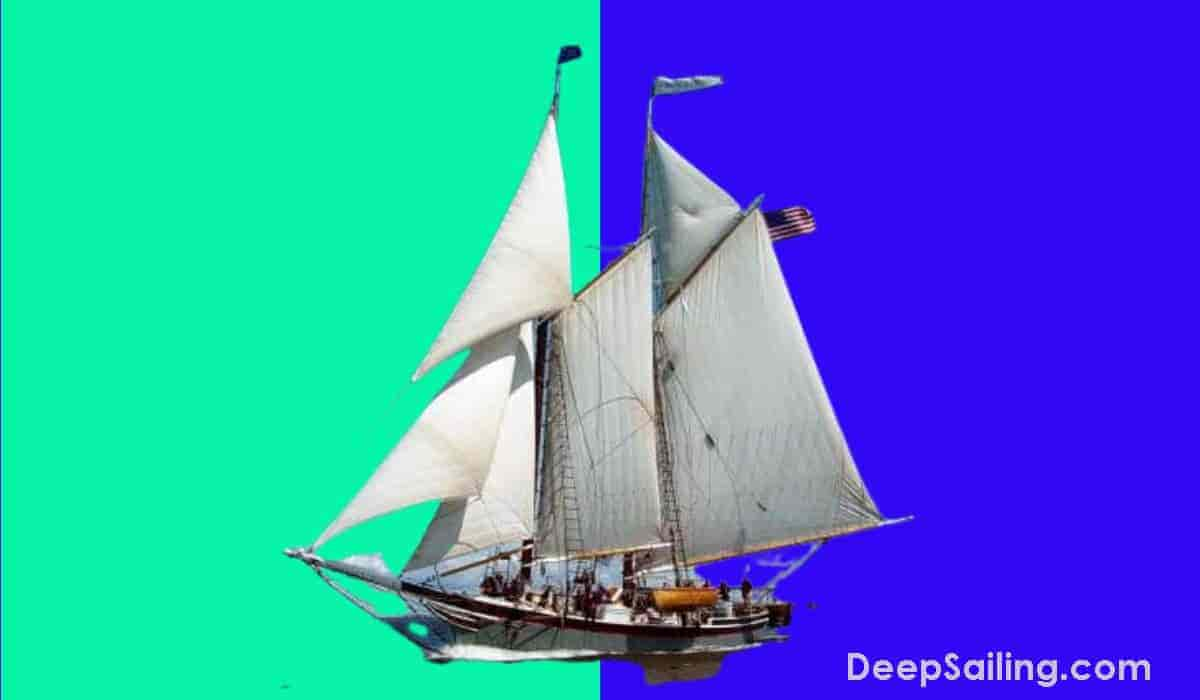
The Schooner sailing vessel, with an average size of 46m (152 feet) in length, was developed in the early 17th century and first used by the Dutch.
The ship came with fore and aft sails and they were created to operate in the toughest of wind and ocean conditions.
The Schooner was a multi-purpose sailing vessel used for transporting slaves to transporting cargo and it was used for fishing and racing too.
There are 5 different schooner types that are characterized by their rig configurations listed below.
- Tern schooner : This was a 3-masted schooner most popular between 1880 and 1920 capable of carrying up to 400 tons in cargo and it required a crew of 6-8 people
- 4-6 masts schooner : These schooners spread the sail area over smaller sails
- Grand Bank Fishing schooner : Similar to the famous Bluenose, it carries the main gaff topsail and a fisherman's staysail set between the masts.
- Square Topsail schooner : This was a combination of fore and aft sails and small square sails, most popularly used for coastal cargo transportation in the 1800s
- Coastal schooner : This was a coastal schooner sailing ship used for carrying goods and general cargo to nearby islands along the coast ( 1 )
The 19th Century schooner came with two or three masts, the one at the fore being shorter than the others.
Modern schooners, with Bermuda rigged sails, remain powerful, economical coastal liners traversing the Pacific.
Famous schooner sailing ships are listed below.
- America : The Schooner named " America " was designed for racing and it became the first winner of the America's Cup international sailing trophy ( 2 )
- Thomas W Lawson : The schooner “ Thomas W Lawson ” had a unique seven masts, with interchangeable sails and gear
- Wawona : The schooner " Wawona " was one of the largest lumber carriers and fishing vessels between 1897 and 1947
2. The Carrack
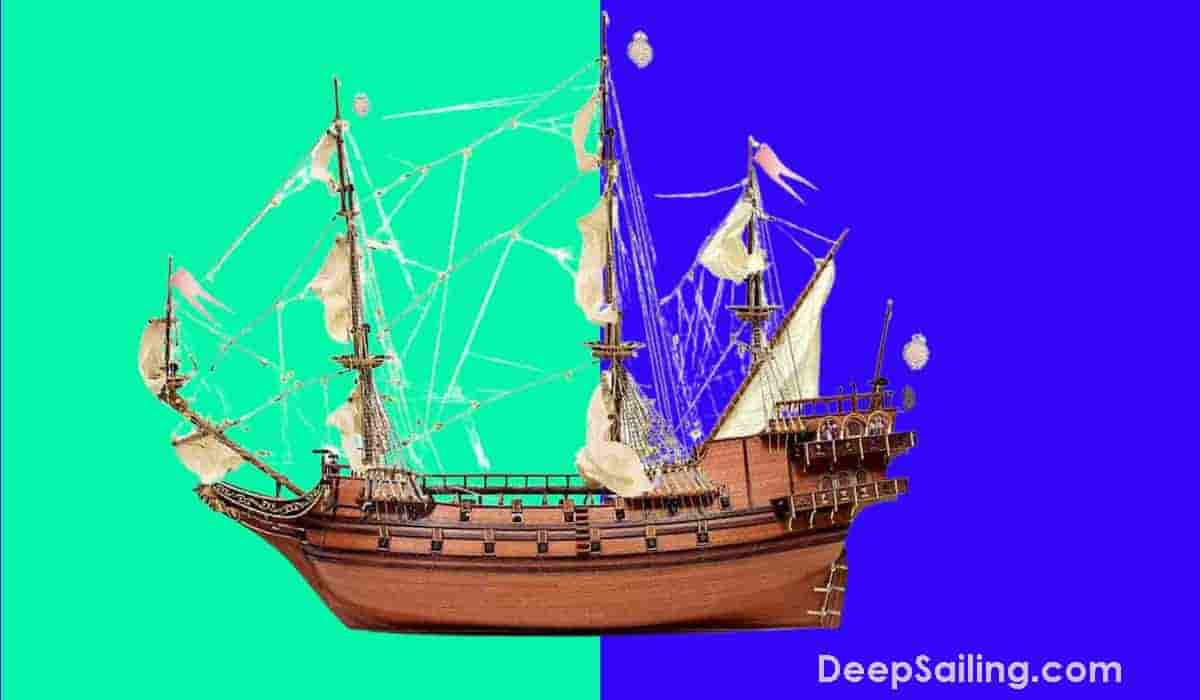
The Carrack, developed in the 14th and 15th centuries with the first built in Portugal, is a nautically-rigged wooden ship with three or four masts each having square sails or triangular sails and it was heavily used between the 14th to 15th Centuries and remained popular until the 18th Century. It is the sailing ship Christopher Columbus used to sail the world.
It was the largest ship in Europe with the Spanish Carrack being more than 1,000 tons in weight and 150 feet (45 meters) in length. More modern versions of the Carrack were developed by the Portuguese and they could hold up to 2,000 tons. ( 3 ).
The Carrack had 4 decks with the lower 2 used for cargo, the 3rd was for accommodation and the 4th was for cargo owned by the crew ( 4 ) and this bulky ship was the standard trading ship along the Baltic, Mediterranean, Asian, and Atlantic coasts in the mid-16th century useful for carrying cargo across seas.
The Carrack had a strange shape which made it cumbersome to sail close to the wind and after a lot of engineering experiments, parts of the ship were stripped off giving the ship a high stern and a low bow.
The modern Carrack features a square-rigged mainmast, foremast, and a latten-rigged Mizzen mast, along with a rounded stern, sizable bowsprit, forecastle, and aft castle.
This is a large ship, built to carry heavy freight for long-distance hauls since it was very steady even in the worst weather with the British Army calling it the “Great Ship” because of its highly-functional ship design.
Famous carrack shipping vessels are listed below.
- Santa Maria : This was the famous ship that Christopher Columbus used to sail and discover America in 1492
- Victoria : The first ship to circumnavigate the globe
- Grace Dieu : This was commissioned by King Henry V and it was one of the largest carrack ships in the world in 1418
- Cinco Chagas : This was presumed to be the richest ship at that time. it was sunk in battle in 1594 ( 5 )
3. The Brigantine
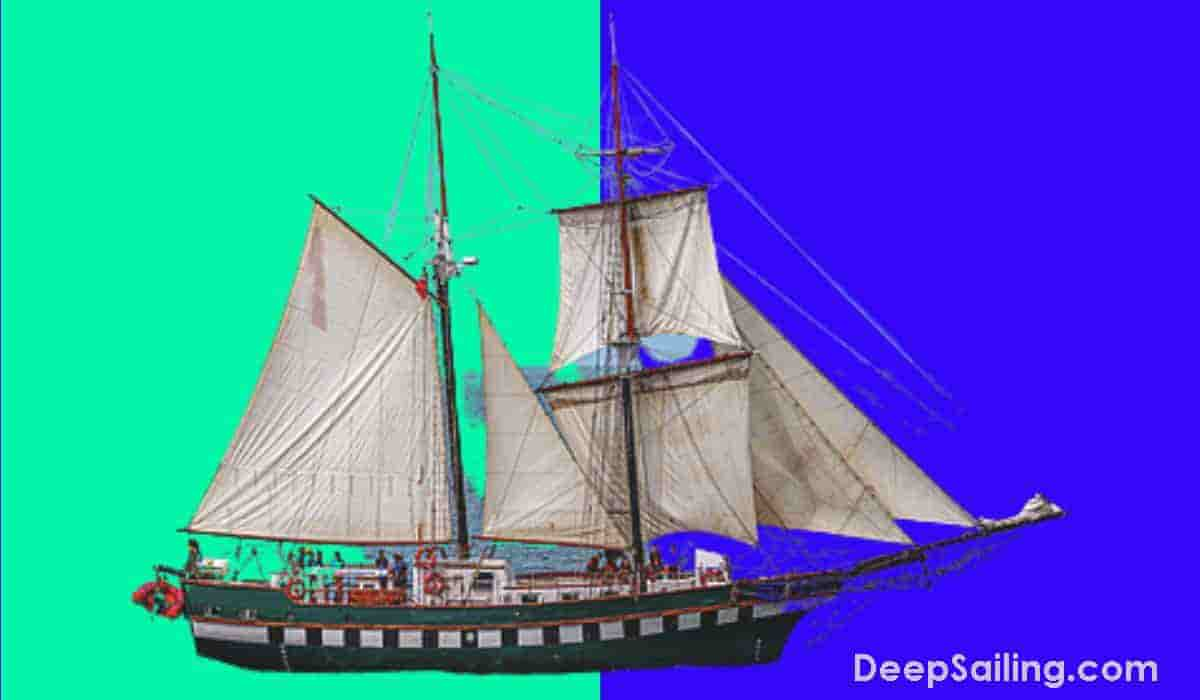
A Brigantine is a two-masted sailing ship with the main mast both a fore-and-aft main sail, a triangular type of sail and a square main topsail that came in various sizes ranging from 30 tons to 150 tons and it could carry a crew of up to 125 people but the shipping vessel could still be handled by a smaller crew if needed.
These ships were similar to the sailing vessel called the Brig as they both had top-gallant sails and were used by the Royal Navy to scout and monitor enemies on the high seas while also being popular amongst pirates as they were faster and easily maneuverable sailing vessels.
It is unclear when the ship was originally built with loose definitions date the ship back to the 13th century when it was originally referred to as the "sail and oar-driven war vessel" ( 6 ) and early academic definitions where the vessel was referred to as the "Brigantine" was first seen in books in the early to mid-16th century ( 7 ).
They would sail across the trade routes of the Baltics and Northern Europe, all the way from Germany to Scandinavia.
The mid-size ships had two sails on the-mainmast with a stripped-down fully-squared rig.
4. The Barquentine
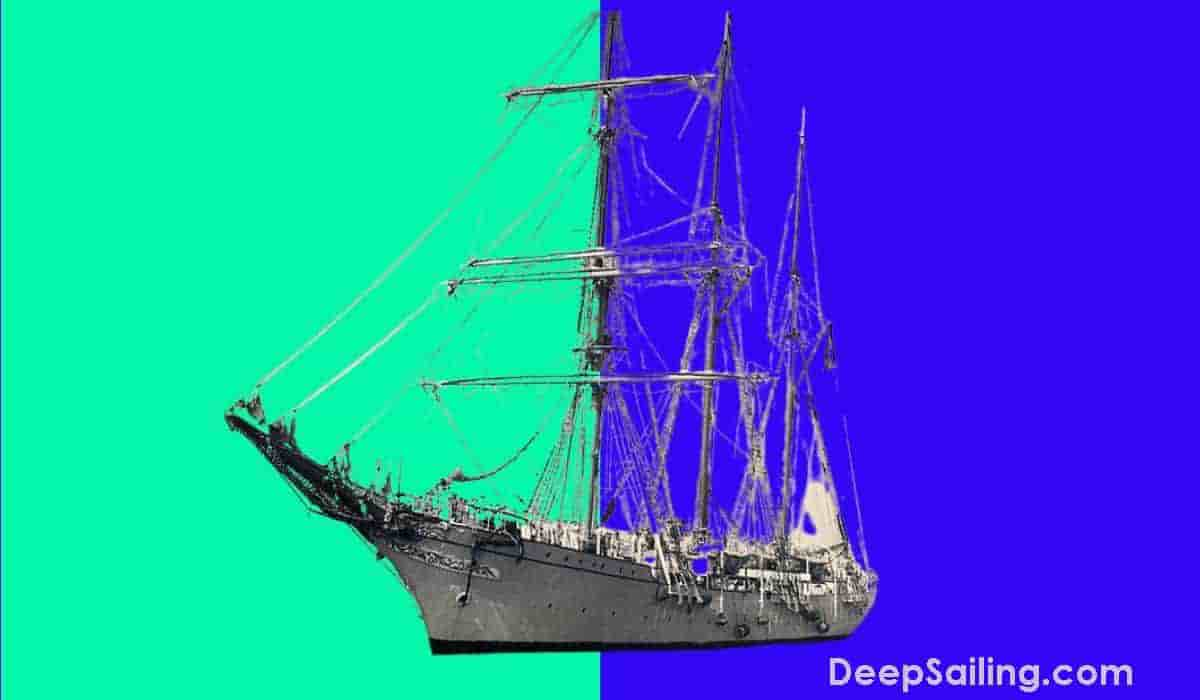
The Barquentine, first built in the 17th century and also referred to as a " schooner barque ", " barkentine " or " schooner bark ", is a sailing ship similar to a barque but with only the foremast square-rigged and the remaining masts rigged fore and aft ( 9 ). They weighed 250 to 500 tons.
The Barquentine has three or more masts and square sails on the fore and aft masts with the main mast had topmast and gaff sails and these had been stripped down to facilitate operation by a slimmer crew and basic rig.
The Barquentine sailed the waters of Northern Europe which were dominated by variable wind speeds and they were popularly used to carry lumber from Scandinavia and Germany to England and the Baltic Areas.
5. The Xebec
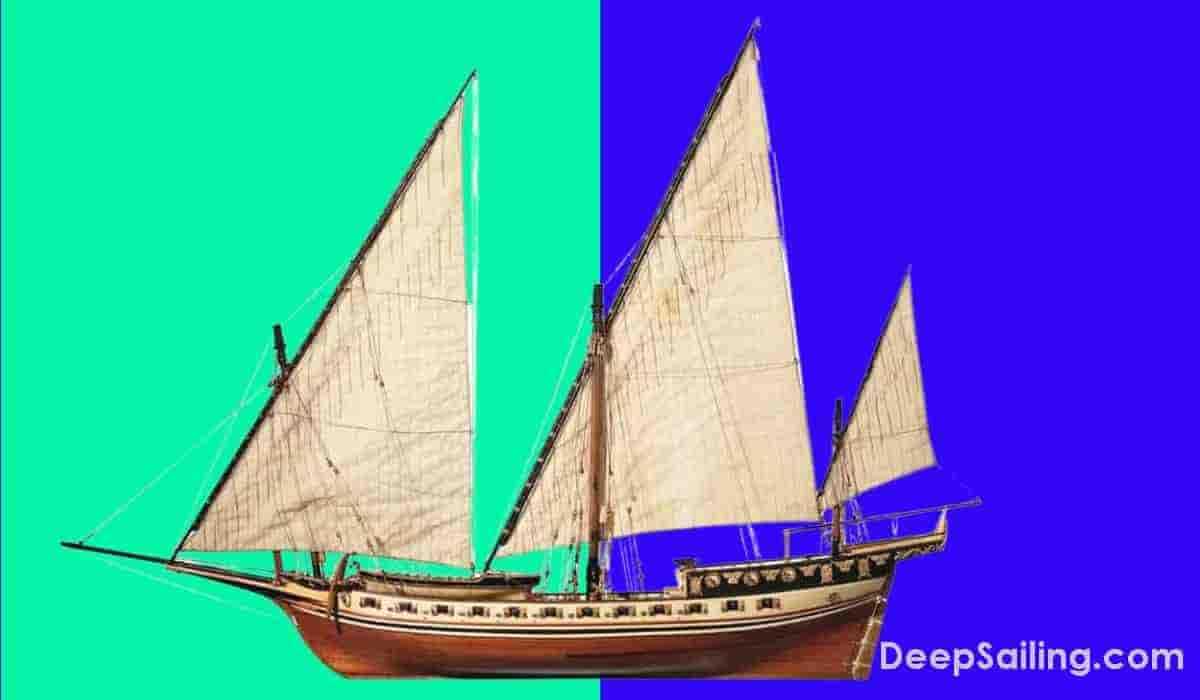
The Xebec, also known as " Zebec ", a name derived from the Arabic word for "Small Ship", was a sailing ship built in the 16th to mid-19th century that was used mainly for moving cargo.
The Xebec sailing vessel held between 90 and 400 crew and was 103ft 9 inches in length with a tonnage of between 200 - 300 tons ( 10 ) and they were very agile and popular with European navies.
The features of the Xebec are listed below.
- Long-prow bulkheads
- Narrow elongated hulls
- Huge lateen yards
- One aft-set mizzen mast
- 3 lateen-pillared masts, both raked forward and having a single triangular sail
Their shallow draft and lateen rig allowed for a closer pinch to the wind allowing them to flee quickly or turn around and fire a broadside volley quickly.
After a lot of engineering experiments, the Xebec gave rise to the Polacre-Xebec, which replaced the mizzen mast. The mainmast of the new derivative also had a square rig and these new vessels were light and could not carry a heavy load with the shallow draft and low free-board making them unsuitable for open-seas sailing.
6. The Barque
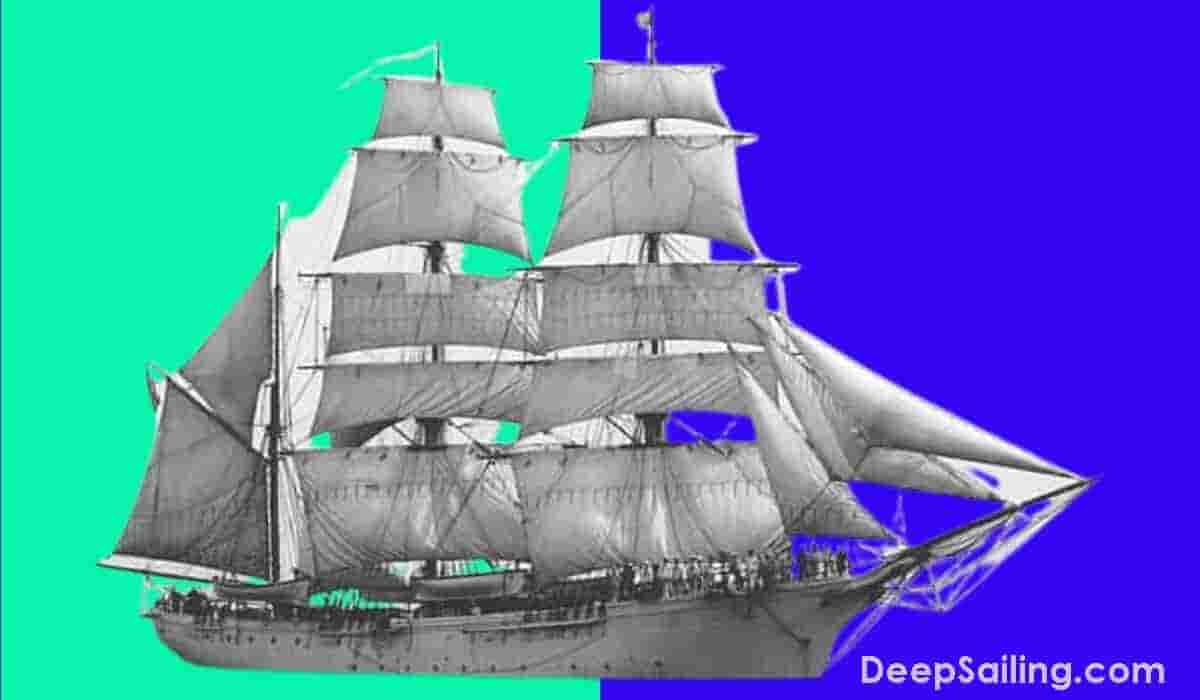
The barque, also referred to as " barc " or " bark ", is a sailing ship first introduced in the 15th century ( 11 ) with 3 or more masts with square sails on all masts, except the aft or mizzen mast. It could carry approximately 500 tons and could hold a crew of 100 people.
Although they are quite similar, the barque should not be confused with the Schooner Bark which is a different vessel.
The Barque ship was commonly used by traders to carry extremely high volumes of cargo from Australia to Europe with cargo mainly consisting of Nitrates and Guano destined for the Western South American coast and they were popular in the period prior to the start of World War II.
7. The Clipper
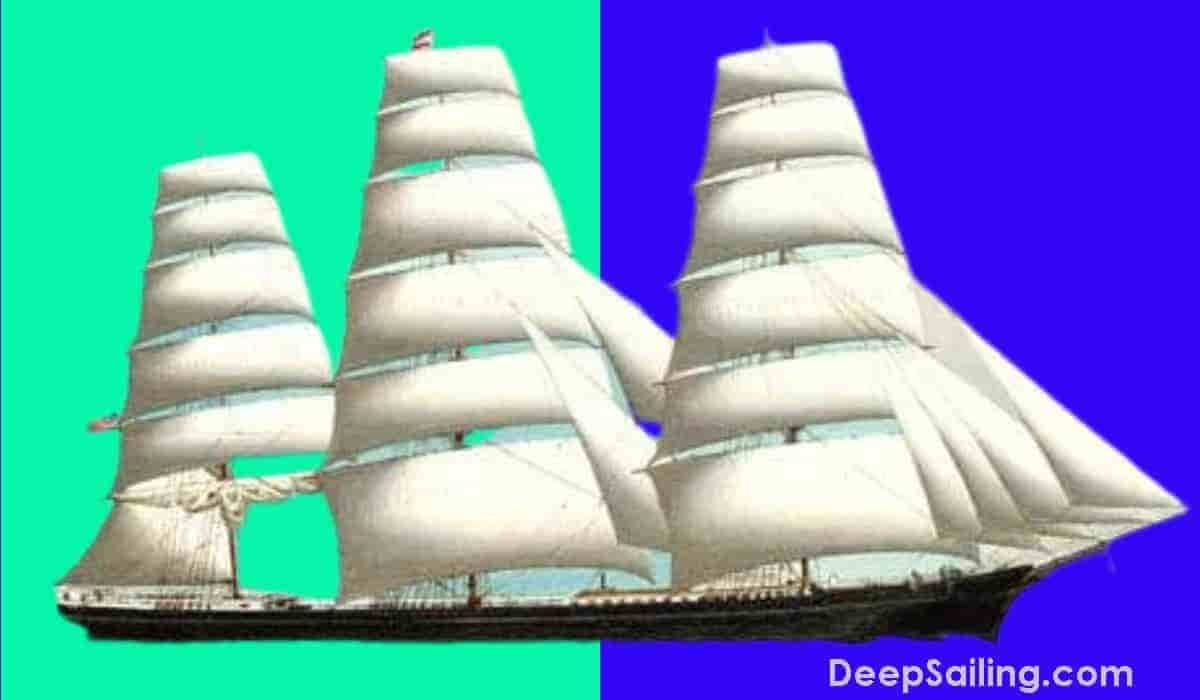
A clipper was a sailing vessel introduced in the mid-19th century that was mainly used as a merchant ship for transporting goods and it was designed for speed.
Clipper ships ranged in size from a few hundred tons to over 4000 tons ( 12 ) and they all had a narrow build, a protruding stern, 3 to 5 masts for speed, and a square rig.
They were most commonly used by British and American traders to ship goods from China to their countries and they were also used to ferry Gold and Tea back to Great Britain and the Americas.
Famous clipper ships are listed below.
- Cisne Branco : This is a steel-hulled built like the original clipper. It is used as a training vessel by the Brazilian navy to this day
- Race Horse : This clipper ship set the record of getting from New York to San Francisco in 109 days in 1850 which was a record at that time
- Marco Polo : This clipper vessel was the first boat of the time to make around trip between England & Australia in under 6 months in 1852
8. The Windjammer
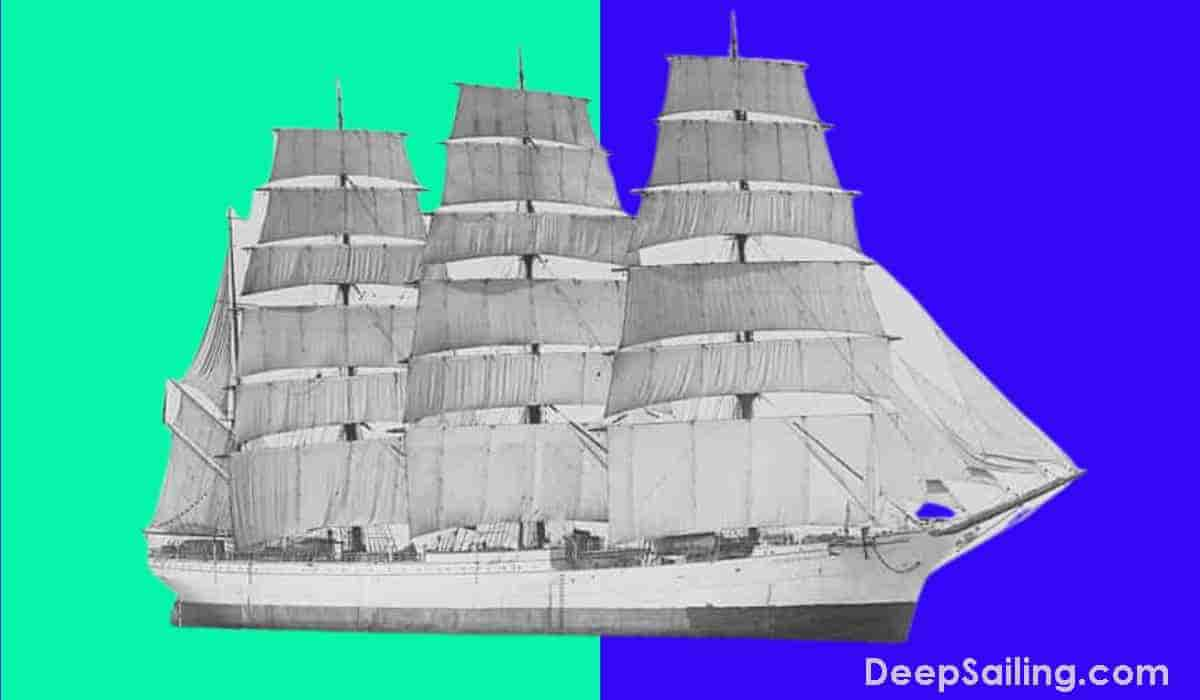
The Windjammer is a commercial sailing ship built in the 19th century with a capacity between 2,000 to 8,000 tons and the speed ranged from 14 to 21 knots ( 13 ).
It came with three to five square-rigged masts and it had a cost-effective extended hull that allowed for larger storage space.
It was a general-class merchant ship and was mainly used to transport bulky cargo and it ferried lumber, coal, and many other goods from one continent to another before evolving from carrying cargo to carrying passengers on cruises in later generations.
9. The Fluyt
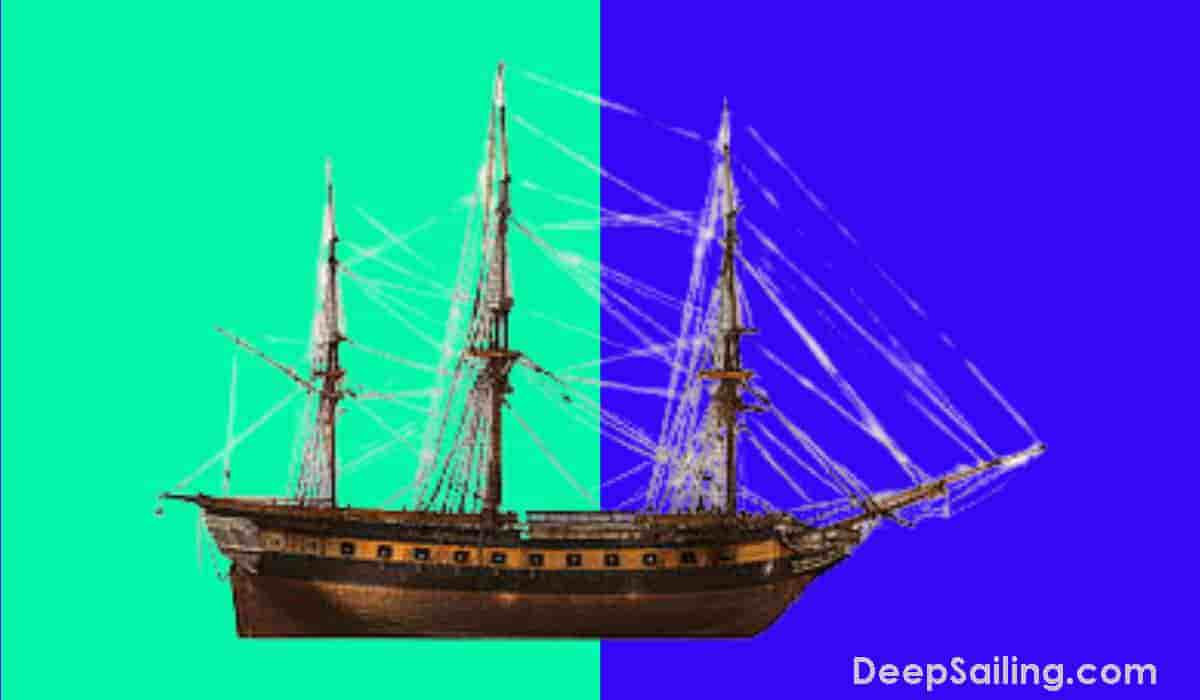
The Fluyt, also known as " fleut " or " fluit " is a sailing ship that originated in the 16th century in the Dutch Republic with a weight between 200 and 300 tons, approximately 80 feet (24 meters) in length, and a crew capacity of 12 - 15 people ( 14 ).
The Fluyt has three squared-rigged masts and was primarily used as a merchant ship to transport cargo.
It was lightly fortified, had a small stern and extended box-style structure, and was crafted using specialized tools to reduce the costs of production and make them affordable to merchants.
10. The Fully-Rigged Ship

A fully rigged ship, also referred to as a "full-rigged ship", is a sailing ship with three or more masts, with all of the masts being square-rigged and the rig, hull, mast, and yards made of iron, wood, or steel.
A full-rigged ship weighed an average 325 tons and could carry a crew of up to 36 people and these ships required a larger crew because of their fully rigged construction ( 15 ).
During the 18th century, a full-rigged ship was also referred to as a " frigate " and they were mainly used for patrolling and for attacking.
A full-rigged ship weighed an average 325 tons and could carry a crew of up to 36 people ( 16 ).
However, towards the end of the 19th century, these ships were stripped down so they could be handled by a smaller crew which helped in easier handling of the sails during the monsoon period when winds would change speed and direction without any warning.
This helped in easier handling of the sails during the monsoon period when winds would change speed and direction without any warning.
A fully rigged ship masts from stern to bow consists of: ( 17 )
- Mainmast : This is the tallest mast on the ship
- Foremast : This is the second tallest mast on the ship
- Mizzenmast : This is the third tallest mast on the sailing vessel
- Jiggermast : If there is a 4th mast, it will be the jiggermast and will be the smallest mast on the ship
11. The Cutter
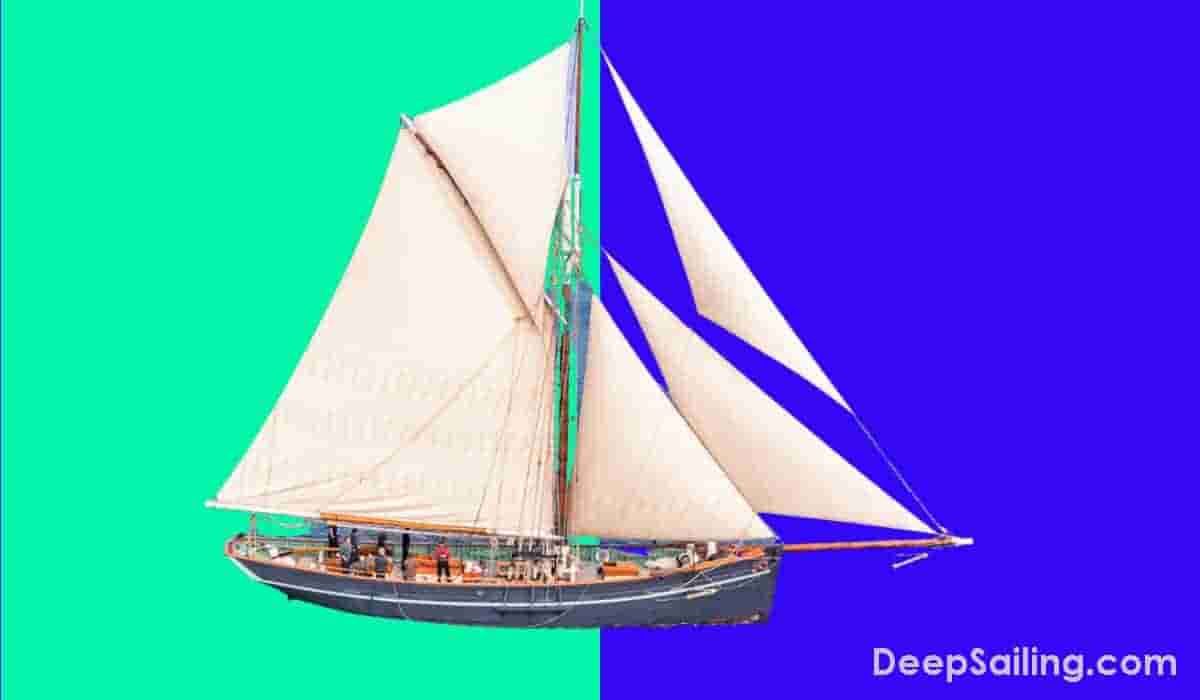
The cutter is a smaller sailing ship built in the early 18th century with a single mast rigged fore and aft and it varied in size from 20ft to 34 ft in length on average with a crew capacity of between 21 to 66 people ( 19 ).
A cutter sailing vessel features: ( 18 )
- Narrow hull
- 2 or more headsails
- Decked sailcraft
- Raking transom
- Vertical stem
- A gaff-rigged long bowsprit
This sailing ship was used for patrolling territorial waters and other enforcement activities during the 18th century and it was used to ferry soldiers and government officials because it was very fast and could outrun any enemy.
Modern-day cutters have a rugged appearance, are small and aptly fit into their intended purpose – speed and agility and the British Sailing Club still has open-oared cutters in their fleet of sailing ships.
12. The Yawl
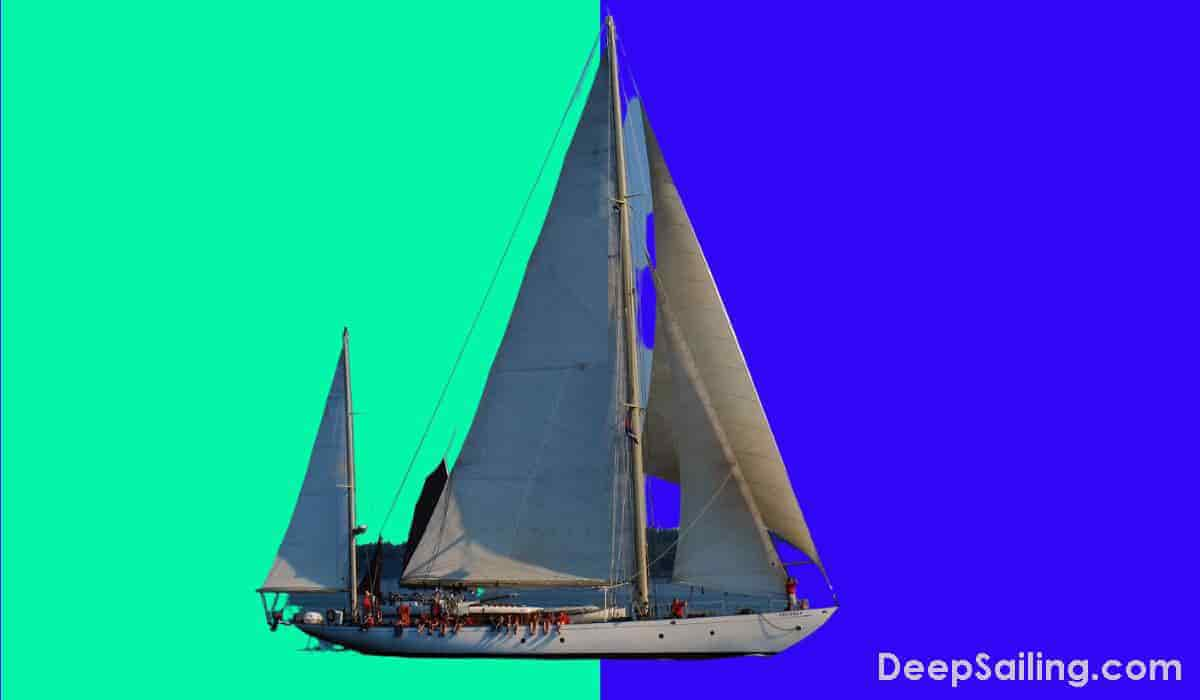
A Yawl is a sailing ship that was originally that was originally a dutch ship nicknamed " Dandy " or " Jol " in Dutch built in the 19th century with a speed range from 10-14 knots, an average crew size of 25 people and a ship size ranging from 30ft to 75ft in length with beam sizes ranging from 10ft to 12ft.
They bore two fully-equipped masts and a fore-and-aft sail, a smaller jigger-mast and a mizzen mast that leans towards the rudder post of the ship with the mizzen sail in this case purposely designed to aid in balancing and trimming the ship on rough waters.
One famous yawl sailing ship is the Islander which was a 34ft yawl that Harry Pidgeon sailed around the world on. He was the second person in 1918 to sail around the world at that time.
13. The Brig
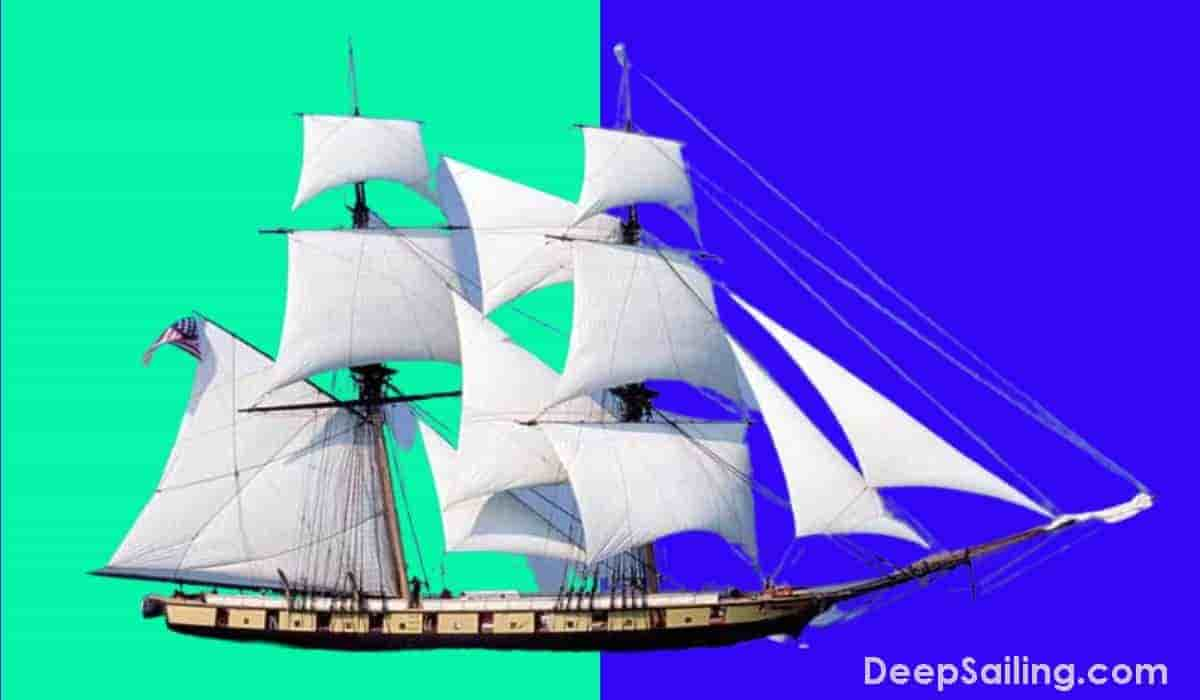
The brig is a two-masted sailing ship that was originally built in the 18th century with square rigging on both masts and sometimes had a spanker on the aft mast.
The length of a brig varied from 75ft to 165ft with tonnages up to 480 ith tonnages up to 480 and it needed a crew of 22 people ( 20 ).
The brig was used as a war vessel and a cargo ship for transporting goods and they were later used to ferry large cargo on the open seas since they could easily follow the direction of the prevailing winds.
It came with a berthing deck that had sleeping quarters for cabin crew and marine officials, storage areas, a sail bin, a wood-paneled stove room, guns, and carronades.
They would be brought into the harbor without using tugs and could maneuver well in small areas.
Famous brig ships are listed below.
- USS Argus : This was a United States Navy brig that fought in the First Barbary War, taking part in the blockage of Tripoli and the war of 1812
- USS Reprisal : This was the first ship of the United States Navy
- USS Somers : This was a brig in the United States Navy that became infamous for being the only US Navy ship to undergo a mutiny
14. The Ketch

A ketch is a two-masted sailboat that originated in the 17th century with most ketch ships ranging from 40ft to over 120ft in size and weighing between 100 and 250 tons. A ketch ship needed a smaller crew of only 4 people to operate ( 21 ).
The ketch looked just like the Yawl and as stated had two masts each having a fore-and-aft rig with the difference between the two being that the ketch had a mizzen mast placed on the taller mainmast but at a position in front of the rudder post. The mizzen in this case aided in maneuvering the vessel.
A ketch ship was used for:
- Cargo Transportation
15. The Hulk
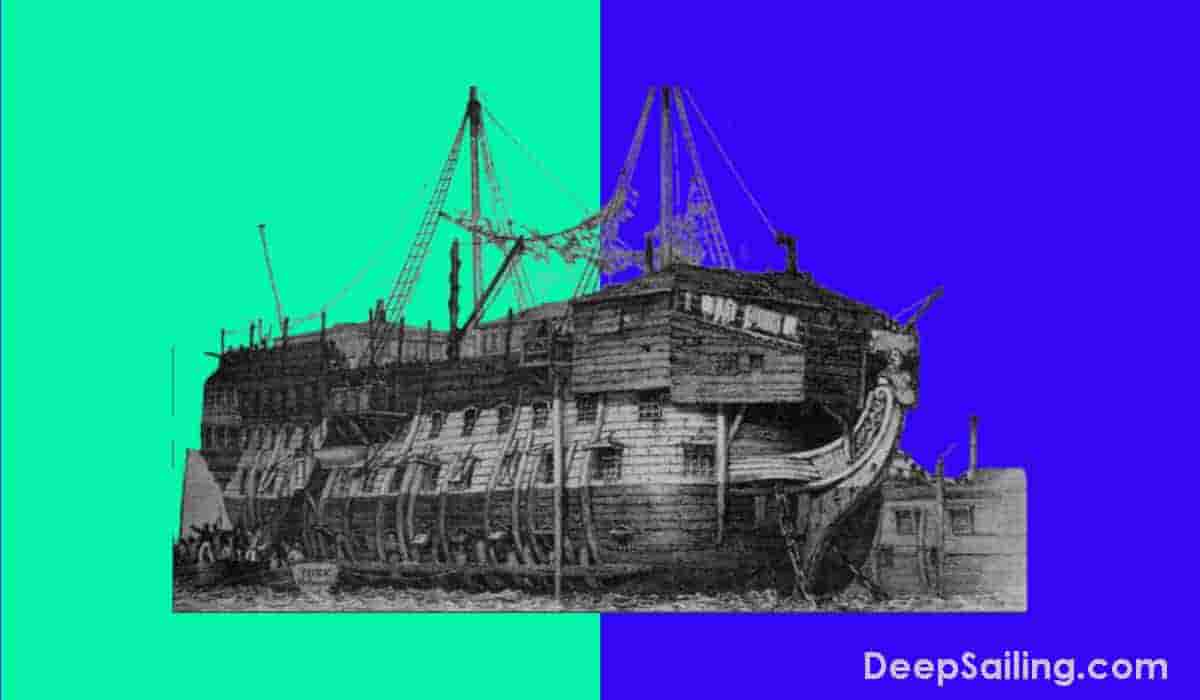
A hulk is an 18th-century ship that is a derivative of the Carrack with a weight of 400 tons that is afloat but incapable of going to sea. In maritime terms, the name "Hulk" was given to ships that were outdated, stripped down or unprofitable to run.
The bulk of the hulk fleet was comprised of abandoned ships, stripped down and therefore could not continue to ply across the Mediterranean Sea as cargo or transport ships.
They are stationary and kept for their buoyancy and were used as a prison, a place for gambling.
- Maritime Museum Of The Atlantic. " Sailing Ship Rigs ".
- The New York Times. " America's Cup Held Here Since 1851 ", PDF.
- World History Encyclopedia. " Carrack Definition ," Paragraph 3.
- Same As Reference 3
- Military History. " Carracks, Famous Carracks ," Paragraph 9.
- " Aken, tjalken en kraken " by Hans Haalmeijer & Dirk Adrianus Vuik, Page 12.
- Google Books Ngram Viewer. " Brigantine ".
- Gaspee Info. " Brigentines Described ," Paragraph 3.
- Wikipedia. " Barquentine ," Paragraph 1.
- " Ship: 5000 Years Of Maritime Adventure " by Brian Lavery, Page 137.
- Oxford English Dictionary (Online Edition). " Barque ".
- University of Houston. " No. 338 Clipper Ship ". Paragraph 2
- Marine Insights. " Windjammer Sailing Ships: From Past to Present ". Paragraph 8
- History Today. " Dutch Shipbuilding in the Golden Age ". Volume 34, No. 1
- " The Story Of The Sea, Volume 1 " by Arthur Quiller-Couch, Page 20.
- Whaling Museum. " Rigs Of Vessel, Ship ," Paragraph 1.
- " A Dictionary of Sea Terms " by Anstead, A, Page 96.
- Britannia. " Cutter, Sailing Craft ". Paragraph 1.
- " The Boats Of Men Of War " by William May & Simon Stephens
- Texas Navy Association. " Glossary Of Nautical Terms ". Page 1
- National Museum Of American History. " Ship Model, Ketch ". Paragraph 1

The Best Sails For Cruising Sailboats
The best sails for cruising sailboats is a much-debated topic. Cruising sailboats, by definition, put a lot of miles under the keel. Naturally, the hope is that a lot of those miles will be powered by nothing but the wind and your wardrobe of sails (the wind sometimes has other ideas).
In this article we run you through some of the best sails for cruising sailboats, their advantages and disadvantages, and the kind of conditions you might want to fly them in.

We’ll take you through everything you need to know, from the primary types of sail you’ll find on a cruising sailboat to the performance-enhancing extras favoured by seasoned circumnavigators.
With more than a decade’s full-time liveaboard experience aboard both monohull and multihull boats with thousands of miles under the keel, we’ve finely tuned our sail wardrobe and have a good idea of what you’re likely to need out on the water.
Table of Contents
What is a cruising sailboat, types of sailboat rig on the cruising sailboat, best sails for cruising sailboats: types of headsail, best sails for cruising sailboats: best mainsail, so what sails do you really need for cruising.

Before we start taking a look at sails it’s important to understand the needs of a cruising sailboat. What makes a cruising sailboat, and how does it differ from say, a racing sailboat?
A cruising sailboat is one that has either been built for, or set up for, living aboard and cruising to multiple ports or anchorages over the span of several weeks, months or even years.
Cruising can be long-distance – AKA bluewater cruising – or it can simply mean living aboard for a couple of weeks while you sail around the Greek Ionian , for example. There’s no exact definition, but to most it means multi-stop, liveaboard sailing for at least a week and usually longer.
When living aboard for an extended time your requirements shift and you start to need more storage for food, personal belongings and parts.
You also want a few more creature comforts aboard, and as such the weight of your vessel (her displacement) will increase accordingly.
Cruising boats are therefore usually those that accept a larger payload and have space for sufficient power generation and storage for long-term life aboard. They can be built with this in mind, or can simply be designs that happen to work well for the job.
Some people will also argue that a cruising sailboat is one that emphasises safety over performance; others will argue that catamarans or monohulls are better for long-term life aboard.
We’re not here to try and solve those questions today – just to point out that there are differences between cruising and racing sailboats, and that those differences will be reflected in the sails.
For example, a racing boat could use tri-radial, mylar-laminated sails to maximise performance. A cruising boat might prefer a sail made of Dacron or perhaps laminated Polyester, trading off some performance for dramatically increased durability.
A cruising boat might also want a headsail with the clew – the aftmost corner – cut high. This slightly reduces the area of the sail but makes it much easier to keep a watch forward. This set of trade-offs is attractive to the long-distance cruiser but not the weekend racer.
We’ll explore everything you need to know in this comprehensive guide.

The best sails for your cruising sailboat depend in part on your rig, because it impacts the sails you can fly.
Cruising sailboat rigs can broadly be split into single and twin-masted, and sails split into those that are flown in ahead of, and aft of, those masts. Sails in front of the mast are headsails; the sail aft of the mast, tensioned by the boom, is usually the mainsail.
In a twin-masted vessel like a ketch, we would also specify whether they fly on the main or the aft mizzen mast. Of course, sailing vessels with three or more masts exist, but you don’t see many circumnavigators sailing off into the sunset at the helm of a Barquentine anymore.
Single-masted cruising sailboats
The most popular single-masted configuration in the world today is the Bermuda-rigged sloop. A sloop has one mast and two main sails: a triangular mainsail aft of the mast, and a triangular headsail usually called a jib or genoa forward of the mast.
As we’ll see in a moment, a sloop can also carry and fly a range of other sails, from storm jibs to cruising chutes , but the key piece of info is that a sloop generally flies two sails at a time.
The next step up in complexity would be something like a cutter rig or Solent rig, which both still have a single mast but also carry a second, differently-sized headsail alongside the first.
The second headsail could be a big, lightweight chute to enable sailing in light airs, or it could be a small, tough storm jib for heavy weather. The point is that with a cutter or Solent rig you have a second sail loaded and ready to go at all times.
What is the difference between a cutter rig and a Solent rig? In a cutter, the inner headsail attaches about a quarter of the way down the mast, resulting in a fairly large gap between the two headsails. This translates to a smaller inner headsail, but easier tacking of the outer headsail (although still much harder than with a sloop).
The Solent rig, on the other hand, has both headsails attached at the masthead and all but touching. This maximises the size of both sails and makes for a powerful rig, but means you have to fully furl away the outer headsail to tack.
As such, the Solent rig is sometimes seen with a big downwind chute or similar on the outer stay, whereas a cutter rig usually has a small, self-tacking jib often called a staysail on the inner stay.
There are of course a dozen other types of single-masted sailboat – from the catboat to the lateen – but we’re talking about the kinds commonly used by cruising sailboats.
When it comes to single-masted cruising sailboats, you’re really choosing between the raw simplicity of a sloop, or trading off a bit of cost and complexity to carry an extra headsail in cutter or Solent configuration.
Many ocean cruisers prefer the extra headsail because redundancy can be a lifesaver offshore, and you rarely tack on ocean passages anyway. Someone cruising the Greek islands a few weeks per year might want to keep things simple and minimise maintenance with a sloop.
It’s worth noting that almost all catamarans are single-masted and use one of the configurations above.
Catamaran sails are conceptually similar, but they are cut and proportioned differently, with a much larger mainsail relative to the headsail (jib) and sometimes a square top.
The large deck real-estate and large bow lockers of a catamaran make it much easier and safer to unfurl and deploy chute-type sails like spinnakers.
Two-masted cruising sailboats
Two-masted cruising sailboats such as ketches and yawls dominated the long-distance sailing scene in the 70’s and 80’s.
Proponents of two-masted boats point to the fact that each individual sail can be smaller and therefore easier to manage, and that carrying more sails translates to redundancy, flexibility and safety. It also means a smaller crew can handle a bigger boat.
Ketches are arguably the most popular. The difference between a ketch and yawl is the size and position of the aft mizzen mast, with the yawl featuring a smaller and further-aft mizzen.
Again, many other varieties of twin-masted rig exist, such as the schooner – which has two large masts of similar size – but they’re not enormously common amongst the cruising crowd.
As previously noted, it’s rare to see multihulls such as catamarans with two-mast rigs, but they do exist – and can either have the two masts in series like a regular ketch, or one on each hull in a “biplane” configuration.
On sailing boats that have two masts, the sails on the main mast are usually referred to as the mainsail and headsail, and sails on the mizzen mast are known as mizzen sails.

Headsails are sails, generally triangular, that are flown out in front of the mast – usually attached to a head stay, a cable running from the masthead down the forestay at the bow of the boat.
Jibs, genoas and Yankees
The most common types of headsail are the jib, genoa and the Yankee . Sailors will argue about the difference between the three; many will use the terms more or less interchangeably.
A common definition is that if stretched out, a genoa would stretch from the bow of the boat to aft of the mast, whereas a jib would stop short.
A Yankee often refers to a jib that has been cut very high, making it easier to see under and “keep a watch”.
You may hear headsails referred to with a “luff percentage”, such as “a 120% genoa”. This means the genoa is 20% larger than the space between the mast and the forestay – it would overshoot the mast and then another 20% – and would therefore be a reasonably large and powerful sail.
Many cruising sailboat skippers will want a couple of kinds of headsail available to suit different conditions, particularly a cruising chute such as a spinnaker or gennaker.
Spinnakers and gennakers
Spinnakers and gennakers are a popular type of large, lightweight headsail that excels at sailing downwind in light air.
Spinnakers are a type of sail that is shaped like a parachute and made from a lightweight fabric that is usually brightly coloured. They are usually symmetrical and flown forward of the mainsail while running more or less dead downwind.
Spinnakers need a pole to control them and often need to be actively managed by the crew, or “flown like a kite”. They can be unruly and challenging for a short-handed crew, but they’re unrivaled in light air. Gennakers are generally considered much easier to handle.
Gennaker is a portmanteau of Genoa and Spinnaker, and represents something halfway in between the two – a little heavier, and also asymmetrical like a Genoa, i.e. flown on one side of the bow or the other and not straight out front.
The upshot of this is that you can’t sail dead downwind, but you can sail right up to a beam reach – from 90 degrees right down to about 140 degrees – whereas a symmetrical sail like a spinnaker is for the 180 degrees (dead downwind) out to perhaps 130.
Both sails are popular with circumnavigating sailors because the average circumnavigation has the wind abaft the beam most of the way – but they’re a great addition to almost any cruising sailboat.
Multihulls like catamarans usually do not sail well dead downwind and will therefore want one of the asymmetric variants.
Storm jibs and staysail: A staple sail on cruising sailboats

At the other end of the scale is the storm jib. This is a 3-sided sail made from heavy cloth, designed to be flown in heavy weather.
A storm jib should be less than 5% of the triangle delineated by the mast and forestay.
Their small size and heavy durable cloth mean they can withstand wind speeds of sustained 30kts or
In theory, you can reef down a larger headsail in a blow. But a purpose-made storm sail will be stronger, and it will present a better shape to the wind than a fat bundle of reefed sailcloth.
Many cutters will have a staysail on the inner forestay, which is a small jib that is commonly set up to be self-tacking. This is not a storm jib but its small size, self-handling and the ability to sheet it right the way to the centreline like the main make it an excellent choice for heavy weather sailing up to 30 or 35 kts.

Where it’s fairly normal to carry multiple headsails, a lot of boats only fly one thing aft of the mast: the mainsail, or simply main.
The main works to balance the forces of the headsails around the mast, and it plays a critical role in upwind performance as it’s able to assume the fairly rigid, wing-like shape boats need to travel upwind.
Main sails usually incorporate some sort of stiffening batten nowadays to help them maintain their shape.
The majority of mainsails are pin-headed, i.e. triangular, ending in a sharp point at the masthead. Multihulls sometimes use a square-top mainsail instead – which is like a triangle with the top point cut off.
Try sails, tri-sales
Some cruising sailboats carry small, heavy-weather mainsails called trysails or tri-sails . A trysail can simply be a small main, but more often they are cut from heavy orange cloth and reinforced with heavy stitching.
The logic of flying a smaller sail in heavy weather, rather than reefing down a big one, is that it’s a lot more aerodynamic – you don’t have the big slug of reefed fabric around the boom.
It also protects your main from the worst weather. Taking your main off and stowing it below is the only surefire way to protect it during a storm.
Riders, ride sails
Riders are small sails that are flown aft of the mast, particularly on a ketch. These are not used to propel the boat, but instead to keep the bow of the boat into the wind while at anchor.
This has the effect of putting any wind-driven waves or swell in the anchor under the bow, and making life much more pleasant for those on board.
Ventilation on sailboats also typically faces forwards, so a ride sail can help with airflow below. Some cruisers argue it will even reduce snatching of the anchor, but we’re not sure about that one.

That’s a lot of information thrown at you if you’re new to sailing, so let’s summarise. What sails do you actually need for long term cruising on a liveaboard sailboat and what sails do we use most regularly?
- A genoa (or job or yankee) . This is one we use all the time and couldn’t be without. You will need a decent foresail to balance the sails well and keep the boat sailing on course. We also use the genoa as our only sail a lot of the time as we can reef it really easily in gusty conditions (which are common in the Med)
- A mainsail. For most people this is their primary sail, the one they will put up pretty much no matter what and often before even leaving the anchorage.
- A storm sail. We see this as an essential even though we haven’t had to rig it yet. It’s the last thing you want to be without when things get really spicy out there.
- A light wind sail. This is optional but super useful. A light wind sail like a spinnaker or gennaker isn’t absolutely essential but is very nice to have if you’re cruising long term.
More sails than this are super useful but we wouldn’t consider them essentials. You will need to decide what’s within your budget and how much space you have onboard.
Note: Many long-term cruisers consider it necessary to carry a spare genoa and mainsail. If you plan on doing lots of long passages or sailing in remote places then spare sails could be literal life-savers. If you plan on pottering around the Med then it is likely you would never find yourself in a situation where you needed a spare sail. If you found yourself with a ripped sail in bad conditions then you’re unlikely to find the safest option to be rigging a new sail, but rather would seek the nearest port.
Conclusion: The Best Sails For Cruisers
Choosing the right sails for cruisers is a crucial decision that directly impacts your sailing experience. Depending on the type of sailing you’re going to be doing, your boat and your experience will affect the sails you need, but having a choice is never a bad thing!
Now that you’ve decided which sails you need you might be wondering where on earth to get them from. This is another thing we painstakingly researched.
You have a few options. The traditional way of buying sails is to go to a local port and use the ‘sailmaker’. Remember the name is deceiving. They’ll simply measure up for you and order your sails from their manufacturer.
The option we found most appealing as cruisers on a budget was to skip the middleman and opt for Precision Sails . You work with them to design the perfect sail for your boat using the measurements you give them (they give you step-by-step instructions that are pretty foolproof).
The voila! Your sail arrives a few weeks later.
We’re thrilled with our mainsail. It’s been designed specifically for a cruising catamaran and the sail designer at Precision Sails worked with us to make sure it was exactly as we wanted it (with professional input of course!) It’s made to the highest standard and makes our boat fly like a beast. We can highly recommend!
Similar Posts

How To Learn To Sail For Free
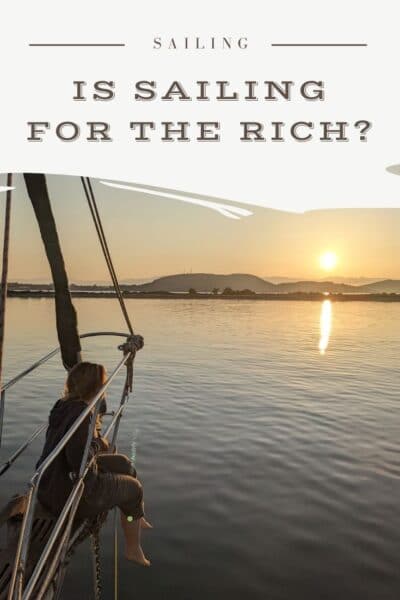
Is Sailing For The Rich?

Canal Cruising In France 2024

Sailboat Living: 10 Things To Know Before Moving On Board

The 11 Most Expensive Sailboats Of 2024
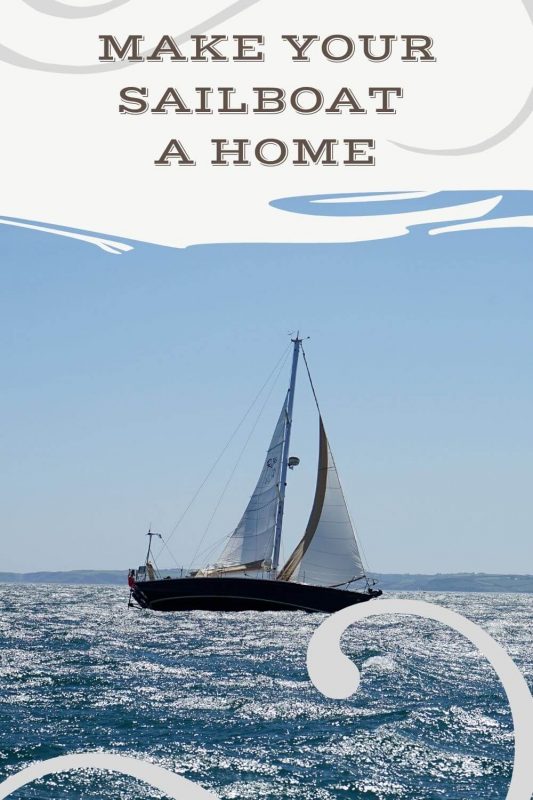
Making Your Sailboat Feel Like Home: Must Have Home Comforts
- Search Search Hi! We’re Emily, Adam and Tiny Cat, liveaboard sailors travelling the world on our 38ft sailboat and writing about it as we go. We hope we can inspire you to live the life you’ve always dreamed, whether that’s exploring the world or living a more simple way of life in a tiny home. Find out more. Patreon
- Privacy Policy
- AI Generator
85 Two Masted Sailboat Stock Photos & High-Res Pictures
Browse 85 two masted sailboat photos and images available, or start a new search to explore more photos and images..
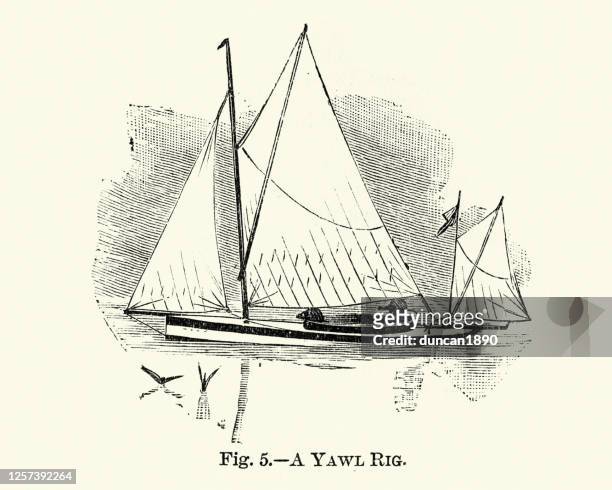
17 Sailboat Types Explained: How To Recognize Them
Ever wondered what type of sailboat you're looking at? Identifying sailboats isn't hard, you just have to know what to look for. In this article, I'll help you.
Every time I'm around a large number of sailboats, I look around in awe (especially with the bigger ones). I recognize some, but with most of them, I'll have to ask the owner. When they answer, I try to hide my ignorance. The words don't make any sense!
So here's a complete list with pictures of the most common sailboat types today. For each of them, I'll explain exactly where the name comes from, and how you can recognize it easily.

So here's my list of popular sailboat types, explained:
Bermuda sloop, sailing hydrofoil, dutch barge, chinese junk, square-rigged tall ship, in conclusion, how to recognize any sailboat.
Before we get started, I wanted to quickly explain what you should look for when you try to identify a sailboat.
The type of sailboat is always determined by one of these four things:
- The type of hull
- The type of keel
- The number of masts
- And the type of sails and rig
The hull is the boat's body. There are basically three hull types: monohull, catamaran, and trimaran. Simply said: do I see one hull, two hulls (catamaran) or three hulls (trimaran)? Most sailboats are monohulls.
Next, there is the keel type. The keel is the underwater part of the hull. Mostly, you won't be able to see that, because it's underwater. So we'll leave that for now.
The sail plan
The last factor is the number of masts and the sail plan. The sail plan, simply put, is the number of sails, the type of sails, and how the sails are mounted to the masts (also called rigging ).
Sailboat are mostly named after the sail plan, but occasionally, a sail type is thrown in there as well.
So now we know what to pay attention to, let's go and check out some sailboats!

Dinghies are the smallest and most simple sailboats around.
They are your typical training sailboats. Small boats with an open hull, with just one mast and one sail. Perfect for learning the ways of the wind.
On average, they are between 6 and 20 ft long. Mostly sailed single-handed (solo). There's no special rigging, just the mainsail. The mainsail is commonly a Bermuda (triangular) mainsail. Dinghies have a simple rudder stick and no special equipment or rigging.
Dinghies are great for learning how to sail. The smaller the boat, the better you feel the impact of your trim and actions.
How to recognize a sailing dinghy:
- short (8ft)
- one Bermuda sail
- open hull design
- rudder stick
Common places to spot them: lakes, near docks

If you'd ask a kid to draw a sailboat, she'll most probably draw this one. The Bermuda Sloop is the most popular and most common sailboat type today. You'll definitely recognize this one.
How to recognize a Bermuda Sloop:
- triangular mainsail (called a Bermuda sail)
- a foresail (also called the jib)
- fore-and-aft rigged
- medium-sized (12 - 50 ft)
Fore-and-aft rigged just means "from front to back". This type of rigging helps to sail upwind.
Any sailboat with one mast and two sails could still be a sloop. Even if the sails are another shape or rigged in another way. For example, here's a gaff-rigged sloop (more on the gaff rig later):

If you want to learn all about sail rigs, check out my full Guide to Understanding Sail Rig Types here. It has good infographics and explains it in more detail
The Bermuda sloop has a lot of advantages over other sailboat types (which is why it's so popular):
- the Bermuda rig is very maneuverable and pretty fast in almost all conditions
- it's really versatile
- you can sail it by yourself without any problems
- it's a simple setup
Common places to spot a sloop: everywhere. Smaller sloops are more common for inland waters, rivers, and lakes. Medium-sized and large sloops are very popular cruising boats.

Cutters have one mast but three or more sails. Most cutters are Bermuda rigged, which means they look a lot like sloops.
How to recognize a cutter:
- looks like a sloop
- two or more headsails instead of one
- commonly one mast
- sometimes an extra mast with mainsail
Cutters have more sail area, which makes them faster, but also harder to sail single-handed. There's also more strain on the mast and rigging.
Common places to spot a cutter: everywhere. Cutters are very popular for cruising.
They mostly have a Bermuda rig, which means triangular sails. But there are also gaff cutters and naval cutters, and some have two masts.
Here's an example of a two-masted naval cutter with an extra gaff mainsail and top gaff:

The Hydrofoil is a pretty new sailboat design. It's a racing sailboat with thin wing foils under the hull. These lift up the hull, out of the water, reducing the displacement to nearly zero. The foils create downforce and keep it from lifting off entirely.
This makes the hydrofoil extremely fast and also impressive.
The hydrofoil refers to the keel type. There are both monohull and multihull hydrofoils.
How to recognize a hydrofoil:
- it flies above the waterline and has small fins
Common places to spot a hydrofoil: at racing events

Famous catamaran: La Vagabonde from Sailing La Vagabonde
A catamaran is a type of cruising and racing multihull sailboat with two hulls. The hulls are always the same size.
Most catamarans have a standard Bermuda rig. The catamaran refers to the hull, so it can have any number of masts, sails, sail types and rig type.
How to recognize a catamaran:
- any boat with two hulls is called a catamaran
Common places to spot catamarans: coastal waters, The Caribbean, shallow reefs
The advantages of a catamaran: Catamarans heel less than monohulls and are more buoyant. Because of the double hull, they don't need as deep a keel to be stable. They have a smaller displacement, making them faster. They also have a very shallow draft. That's why catamarans are so popular in the Caribbean, where there's lots of shallow water.
Catamarans are nearly impossible to capsize:
"Compared with a monohull, a cruising catamaran sailboat has a high initial resistance to heeling and capsize—a fifty-footer requires four times the force to initiate a capsize than an equivalent monohull." Source: Wikipedia

How to recognize a trimaran:
- any boat with three hulls is called a trimaran
Trimarans have three hulls, so it's a multi-hull design. It's mostly a regular monohull with two smaller hulls or floaters on the sides. Some trimarans can be trailered by winching in the auxiliary hulls, like this:

This makes them very suitable for long-term cruising, but also for regular docking. This is great for crowded areas and small berths, like in the Mediterranean. It sure is more cost-effective than the catamaran (but you also don't have the extra storage and living space!).
Common places to spot Trimarans: mostly popular for long-term cruising, you'll find the trimaran in coastal areas.

Gaffer refers to gaff-rigged, which is the way the sails are rigged. A gaff rig is a rectangular sail with a top pole, or 'spar', which attaches it to the mast. This pole is called the 'gaff'. To hoist the mainsail, you hoist this top spar with a separate halyard. Most gaffers carry additional gaff topsails as well.
Gaff rigs are a bit less versatile than sloops. Because of the gaff, they can have a larger sail area. So they will perform better with downwind points of sail. Upwind, however, they handle less well.
How to recognize a gaffer:
- sail is rectangular
- mainsail has a top pole (or spar)
Since a gaffer refers to the rig type, and not the mast configuration or keel type, all sailboats with this kind of rigging can be called 'gaffers'.
Common places to spot a gaffer: Gaffers are popular inland sailboats. It's a more traditional rig, being used recreationally.

Schooners used to be extremely popular before sloops took over. Schooners are easy to sail but slower than sloops. They handle better than sloops in all comfortable (cruising) points of sail, except for upwind.
How to recognize a schooner:
- mostly two masts
- smaller mast in front
- taller mast in the back
- fore-and-aft rigged sails
- gaff-rigged mainsails (spar on top of the sail)
Common places to spot a schooner: coastal marinas, bays

How to recognize a ketch:
- medium-sized (30 ft and up)
- smaller mast in back
- taller mast in front
- both masts have a mainsail
The ketch refers to the sail plan (mast configuration and type of rig). Ketches actually handle really well. The back mast (mizzenmast) powers the hull, giving the skipper more control. Because of the extra mainsail, the ketch has shorter masts. This means less stress on masts and rigging, and less heel.
Common places to spot a ketch: larger marinas, coastal regions

How to recognize a yawl:
- main mast in front
- much smaller mast in the back
- back mast doesn't carry a mainsail
The aft mast is called a mizzenmast. Most ketches are gaff-rigged, so they have a spar at the top of the sail. They sometimes carry gaff topsails. They are harder to sail than sloops.
The yawl refers to the sail plan (mast configuration and type of rig).
Common places to spot a yawl: they are not as popular as sloops, and most yawls are vintage sailboat models. You'll find most being used as daysailers on lakes and in bays.

Dutch Barges are very traditional cargo ships for inland waters. My hometown is literally littered with a very well-known type of barge, the Skutsje. This is a Frisian design with leeboards.
Skutsjes don't have a keel but use leeboards for stability instead, which are the 'swords' or boards on the side of the hull.
How to recognize a Dutch Barge:
- most barges have one or two masts
- large, wooden masts
- leeboards (wooden wings on the side of the hull)
- mostly gaff-rigged sails (pole on top of the sail, attached to mast)
- a ducktail transom

The clipper is one of the latest sailboat designs before steam-powered vessels took over. The cutter has a large cargo area for transporting cargo. But they also needed to be fast to compete with steam vessels. It's a large, yet surprisingly fast sailboat model, and is known for its good handling.
This made them good for trade, especially transporting valuable goods like tea or spices.
How to recognize a Clipper:
- mostly three masts
- square-rigged sails
- narrow but long, steel hull
Common places to spot a clipper: inland waters, used as houseboats, but coastal waters as well. There are a lot of clippers on the Frisian Lakes and Waddenzee in The Netherlands (where I live).

This particular junk is Satu, from the Chesapeake Bay Area.
The Chinese Junk is an ancient type of sailboat. Junks were used to sail to Indonesia and India from the start of the Middle Ages onward (500 AD). The word junk supposedly comes from the Chinese word 'jung', meaning 'floating house'.
How to recognize a Chinese junk:
- medium-sized (30 - 50 ft)
- large, flat sails with full-length battens
- stern (back of the hull) opens up in a high deck
- mostly two masts (sometimes one)
- with two mainsails, sails are traditionally maroon
- lug-rigged sails
The junk has a large sail area. The full-length battens make sure the sails stay flat. It's one of the flattest sails around, which makes it good for downwind courses. This also comes at a cost: the junk doesn't sail as well upwind.

The cat rig is a sail plan with most commonly just one mast and one sail, the mainsail.
Most sailing dinghies are cats, but there are also larger boats with this type of sail plan. The picture above is a great example.
How to recognize a cat rig:
- smaller boats
- mostly one mast
- one sail per mast
- no standing rigging
Cat-rigged refers to the rigging, not the mast configuration or sail type. So you can have cats with a Bermuda sail (called a Bermuda Cat) or gaff-rigged sail (called a Gaff Cat), and so on. There are also Cat Ketches and Cat Schooners, for example. These have two masts.
The important thing to know is: cats have one sail per mast and no standing rigging .
Most typical place to spot Cats: lakes and inland waters

Famous brig: HMS Beagle (Charles Darwin's ship)
A brig was a very popular type of small warship of the U.S. navy during the 19th century. They were used in the American Revolution and other wars with the United Kingdom. They carry 10-18 guns and are relatively fast and maneuverable. They required less crew than a square-rigged ship.
How to recognize a brig:
- square-rigged foremast
- mainmast square-rigged or square-rigged and gaff-rigged

How to recognize a tall ship:
- three or four masts
- square sails with a pole across the top
- multiple square sails on each mast
- a lot of lines and rigging
Square-rigged ships, or tall ships, are what we think of when we think of pirate ships. Now, most pirate ships weren't actually tall ships, but they come from around the same period. They used to be built from wood, but more modern tall ships are nearly always steel.
Tall ships have three or four masts and square sails which are square-rigged. That means they are attached to the masts with yards.
We have the tall ship races every four years, where dozens of tall ships meet and race just offshore.
Most common place to spot Tall Ships: Museums, special events, open ocean

This is a bonus type since it is not very common anymore. As far as I know, there's only one left.
The Trabaccolo is a small cargo ship used in the Adriatic Sea. It has lug sails. A lug rig is a rectangular sail, but on a long pole or yard that runs fore-and-aft. It was a popular Venetian sailboat used for trade.
The name comes from the Italian word trabacca , which means tent, referring to the sails.
How to recognize a Trabaccolo:
- wide and short hull
- sails look like a tent
Most common place to spot Trabaccolo's: the Marine Museum of Cesenatico has a fully restored Trabaccolo.
So, there you have it. Now you know what to look for, and how to recognize the most common sailboat types easily. Next time you encounter a magnificent sailboat, you'll know what it's called - or where to find out quickly.

I loved this article. I had no idea there were so many kinds of sailboats.
i have a large sailing boat about 28ft. that im having a difficult time identifying. it was my fathers & unfortunately hes passed away now. any helpful information would be appreciated.
Jorge Eusali Castro Archbold
I find a saleboat boat but i can find the módem…os registré out off bru’x, and the saleboat name is TADCOZ, can you tell me who to go about this matter in getting info.thank con voz your time…
Leave a comment
You may also like, guide to understanding sail rig types (with pictures).
There are a lot of different sail rig types and it can be difficult to remember what's what. So I've come up with a system. Let me explain it in this article.

The Ultimate Guide to Sail Types and Rigs (with Pictures)

How Much Sailboats Cost On Average (380+ Prices Compared)
Own your first boat within a year on any budget.
A sailboat doesn't have to be expensive if you know what you're doing. If you want to learn how to make your sailing dream reality within a year, leave your email and I'll send you free updates . I don't like spam - I will only send helpful content.
Ready to Own Your First Boat?
Just tell us the best email address to send your tips to:

Types of Sailboats by Type of Rig
16 December 2015
To have a better idea of which types of sailboats would best suit your needs, your Allied Yachting broker can advise you on the various options available on the market for new or second-hand vessels as well as new construction. In the meantime, here is a summarized guide to the different categories of sailing yachts by type of rig , whether they are monohull (single hull) or multihull , as they’re called in the Mediterranean.
Sailboats by rig type: hulls, masts

Single masted sailboat with monohull
The most common monohull modern sailing yacht is the sloop, which features one mast and two sails, thus sloops are single-masted sailboats. If they have just two sails — a foresail and a headsail — then they’re a Bermudan sloop, the purest type of sailboat. This simple configuration is very efficient for sailing into the wind.
Sailing sloops with moderate rigs are probably the most popular of all cruising sailboats. Just a single-masted sailboat with two sails (a foresail or headsail, and a mainsail) and the minimum of rigging and sail control lines they are relatively simple to operate and less expensive than rigs with multiple masts.
Sloops are adapted for cruising as well as racing, depending on the height and size of their rig.
The cutter sailing yacht is also a monohull similar to a sloop with a single mast and mainsail but generally carries the mast further aft to allow for a jib and staysail to be attached to the head stay and inner forestay, respectively. Once a common racing configuration, today it gives versatility to cruising boats, especially in allowing a small staysail to be flown from the inner stay in high winds.
Thus, a cutter-rig sailboat has an additional sail (the staysail) set on its own stay between the foresail and the headsail.
Cutters are mostly adapted for cruising, but capable of good performance while racing as well.
A ketch is a two-masted sailboat, the main-mast forward and a shorter mizzen mast aft.
But not all two-masted sailboats are ketches — they might be yawls.
A ketch may also carry a staysail, with or without a bowsprit, in which case it would be known as a cutter-rigged ketch.
Ketches are also monohulls, but there is a second shorter mast astern of the mainmast, but forward of the rudder post. The second sailboat mast is called the mizzen mast and its sail is called the mizzen sail.
Yawls have their origins as old-time sail fishing boats, where the small mizzen sail was trimmed to keep the vessel steady when hauling the nets.
Similar to a ketch, the difference being that the yawl has the mizzen mast positioned aft of the rudder post whereas the ketch has its mizzen mast ahead of the rudder post.
Thus, a yawl is also a monohull, similar to a ketch, with a shorter mizzen mast carried astern the rudderpost more for balancing the helm than propulsion.
Schooners are generally the largest monohull sailing yachts.
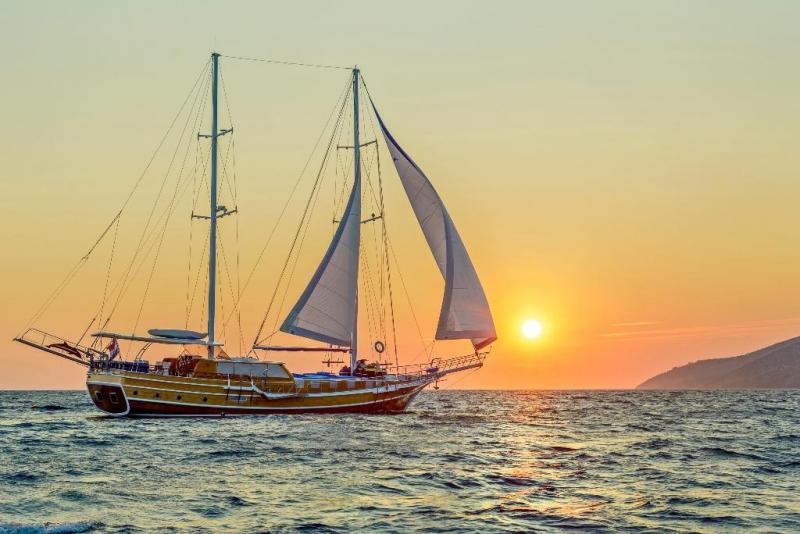
Monohull two masts sailing boat
A schooner has a mainmast taller than its foremast, distinguishing it from a ketch or a yawl. A schooner can have more than two masts, with the foremast always lower than the foremost main. Traditional topsail schooners have topmasts allowing triangular topsails sails to be flown above their gaff sails; many modern schooners are Bermuda rigged.
A schooner is a two-(or more) masted sailboat, in which the aft-most mast – the mainmast – is the same height or taller than the foremast. Many sailors agree that of all the different types of sailboats, a schooner under full sail is one of the most beautiful sights afloat.
Gaffed-rigged sailboats, or “gaffers”, have their mainsail supported by a spar – the “gaff” – which is hauled up the mast by a separate halyard. Often these types of sailboats are rigged with a topsail. The gaff rig is no longer seen on modern production yachts.
A catamaran (‘cat’ for short) is a multihull yacht consisting of two parallel hulls of equal size.
A catamaran is geometry-stabilized, that is, it derives its stability from its wide beam, rather than having a ballasted keel like a monohull. Being ballast-free and lighter than a monohull, a catamaran can have a very shallow draught. The two hulls will be much finer than a monohull’s, allowing reduced drag and faster speeds in some conditions, although the high wetted surface area is detrimental in lower wind speeds, but allows much more accommodations, living and entertaining space in stability and comfort.
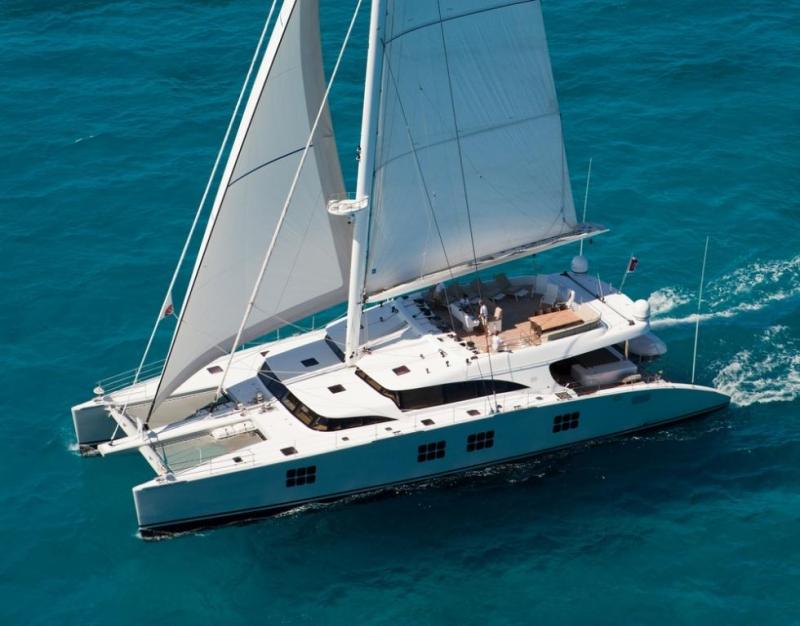
Two parallel hulls sailing catamaran
The speed and stability of these catamarans have made them a popular pleasure craft in Europe, most high-quality catamarans are built in France, but careful since their wide beams aren’t easy (or cheap) to berth in the French Riviera.
Racing catamarans technology has made them today’s leading racing sailboats of the world, like in the latest editions of America’s cup or other renowned transoceanic races.
Please surf through our website listings of sailing catamarans .
OTHER MULTIHULLS
Even harder to berth in the Mediterranean, and most commonly designed for around-the-globe racing rather than cruising, the trimarans have also been gaining some popularity in the western hemisphere, especially by naval designers with futuristic projects.
A trimaran is a multihull boat that comprises a main hull and two smaller outrigger hulls (or ‘floats’) which are attached to the main hull with lateral beams.
MOTORSAILER
A motorsailer or “motorsailor”, is a type of sailing vessel, typically a pleasure yacht, that derives propulsion from its sails and engine(s) in equal measure.
While the sailing yacht appeals primarily to the purist sailing enthusiast, the motorsailer is more suited for long-distance cruising, as a home for ‘live-aboard’ yachtsmen. The special features of the motorsailer (large engine, smaller sails, etc.) mean that, while it may not be the fastest boat under sail, the vessel is easily handled by a small crew. As such, it can be ideal for retired people who might not be entirely physically able to handle large sail areas. In heavy weather, the motorsailer’s large engine allows it to punch into a headwind when necessary to make landfall, without endless tacking to windward.
The Turkish word gulet is a loanword from the French goélette, meaning ‘schooner’.
A gulet is a traditional design of a two-masted (more common) or even three-masted wooden sailing vessel from the southwestern coast of Turkey, particularly built in the coastal towns of Bodrum and Marmaris; although similar vessels can be found all around the eastern Mediterranean. For considerations of crew economy, Diesel power is commonly used on these vessels, similar to a motorsailer. Today, this type of vessel, varying in size from 14 to 45 meters, is very popular and affordable for tourist charters in Turkey, the Aegean, Greece and up to Croatia in the Adriatic.
Please surf through our website listings of cruising sailing yachts by type of rig.
OUR YACHT LISTINGS:
- New Yachts for Sale
- Pre-owned Yachts for Sale
- Yachts for Charter
You might also like

Yachting Consultants
Sale-Charter-Brokerage-Management
Headquarters:
34 Rue Caffarelli 06000 Nice, France
Front Office:
Boulevard de La Croisette – Port Canto 06400 Cannes, France
T.: +33 493 43 82 83 Email: [email protected] Website: www.alliedyachting.com

Bangor Daily News
Maine news, sports, politics, election results, and obituaries
Coast Guard tall ship Eagle coming to Rockland

Share this:
- Click to share on Twitter (Opens in new window)
- Click to share on Facebook (Opens in new window)
- Click to share on Reddit (Opens in new window)
- Click to print (Opens in new window)
- Click to email a link to a friend (Opens in new window)

The U.S. Coast Guard’s tall ship The Eagle is coming to Rockland this summer.
The Eagle is tentatively scheduled to arrive on Friday, Aug. 2 . According to the Maine Lighthouse Museum, the ship will moor at the Rockland Coast Guard station, and the visit will coincide with the Maine Lobster Festival.
The 295-foot, three-masted barque, based in New London, Connecticut, is used as a training vessel for academy cadets and future Coast Guard officers. It is one of two active commissioned sailing vessels in the U.S. military, the other being the USS Constitution, a three-masted frigate known as “Old Ironsides,” based in Boston.
Correction: An earlier version of this story incorrectly stated that the Eagle was hit by another ship in Rockland. It was not. That was the schooner American Eagle.
More articles from the BDN
Ethan andrews.
Ethan Andrews is the night editor. He was formerly the managing editor at The Free Press and worked as a reporter for The Republican Journal and Pen Bay Pilot. More by Ethan Andrews

IMAGES
VIDEO
COMMENTS
Yawl. A yawl is one of the most common types of two-mast sailboats. It has two masts: a mizzenmast and the mainmast. The mizzenmast is usually much shorter than the mainmast. This makes it an oblique type of a sailboat in the sense that the mainmast is located in the front of the boat while the mizzenmast is located in the rear past or the boat.
4. 1977 Puma 38 Ketch. The Puma 38 Ketch is a two-masted sailboat built for racing like the rest of the Puma sailing line. This brand prides itself on speed and maneuverability. The 1977 Puma 38 is 34 feet in length with a backup diesel engine that can help you get where you need to go as well as docking into a slip.
A yawl is a two-masted sailboat with a shorter mizzenmast located behind the mainmast, usually behind the rudder post. The smaller mizzen sail on the aft mast can be used to balance the boat and provide additional power in light winds, while the larger mainsail on the main mast can be used for more power in stronger winds.
Ketch is a type of sailboat that features two masts and two sails, commonly used as a racing and cruising boat. The mainmast of this two-masted sailboat is typically taller than the mizzen mast (aft-mast). Its name derives from catch. Taller masts allow you to use larger sails, so ketch boats are able to achieve better speeds than similar boats ...
Two-masted sailboats, with their elegant profiles slicing through the waves, serve as a bridge between the past and present, combining traditional sailing heritage with contemporary performance. These vessels, marked by their dual masts—the foremast and the mainmast—embody a blend of artistry and engineering, appealing to a wide array of ...
Five Ocean-Going Sailboats With Two Masts. Some of the most reputable boat builders in the world favor ketch and yawl rigs. Some popular sailboats with two masts used nowadays include the Nicholson 38, the Bayfield 40, the Amel Super Maramu, the Hinckley Bermuda 40, and the Bowman 46. Let's look at each model.
A ketch is a specific type of sailing rig characterized by the arrangement and size of the masts and sails. These are two-masted vessels that include a mizzenmast and a larger main mast, with a sloop-like jib. Ketches are typically over 40 feet in length, simply due to a need for significant power in a manageable size.
The two-masted rigs are: Lugger - two masts (mizzen), with lugsail (a cross between gaff rig and lateen rig) on both masts. Yawl - two masts (mizzen), fore-and-aft rigged on both masts. Main mast is much taller than mizzen. Mizzen without a mainsail. Ketch - two masts (mizzen), fore-and-aft rigged on both masts.
A ketch is a two-masted sailboat. The rear mast, called the mizzen mast, is shorter than the forward main mast. The mizzen mast is mounted forward of the rudder post. Read more. Yawl. 02. A yawl is similar to a ketch, but the rear mizzen mast is moved farther aft, behind the rudder post. This makes the mizzen on a yawl seem like an afterthought ...
A brigantine is a two-masted sailing vessel with a fully square-rigged foremast and at least two sails on the main mast: a square topsail and a gaff sail mainsail (behind the mast). The main mast is the second and taller of the two masts. Older usages are looser; in addition to the rigorous definition above (attested from 1695 [citation needed]), the Oxford English Dictionary includes two c ...
The schooner is a classic sailboat, by definition having at least two masts with the main master being longer than the foremast. Although most have only two masts, they can have three or more, depending on the setup. ... Schooner yachts are large, two-or-more masted, traditional sailing vessels usually used for time-honored yachting activities ...
Schooner: A schooner is a sailboat with at least two masts, with the forward mast (foremast) being a bit shorter than the main mast. Although a schooner can have more than two masts, most were just two. During the time of their popularity, this smaller and better upwind setup allowed for a more efficient and manageable sailboat.
Schooner. A schooner is another boat with 2 masts, but can also have more. Like the brig and brigantine, a two-masted schooner has a foremast and an aft mast, the latter essentially being the mainmast. The main characteristic of the schooner is the masts are almost the same size, with the foremost mast sometimes being slightly shorter.
A Two-Masted Sailboat Provides More Rough Weather Choices If a cruiser encounters higher-than-expected winds, having more sails, and thus more alternatives, can be extremely beneficial. Most ketch-rigged boats, for instance, can rest nicely in rising winds and waves with only the mizzen being used to hold the boat's bow facing up into the ...
Tern schooner: This was a 3-masted schooner most popular between 1880 and 1920 capable of carrying up to 400 tons in cargo and it required a crew of 6-8 people; ... A Brigantine is a two-masted sailing ship with the main mast both a fore-and-aft main sail, a triangular type of sail and a square main topsail that came in various sizes ranging ...
A yawl is one of the typical two-masted sailing boats. It has two masts: a mizzen mast and the main mast. The mizzen mast is usually much shorter than the main mast. So, it is a leaning sailboat where the main mast is in the front part of the boat while the mizzen mast is in the back part. The mizzen mast of a yawl is used to improve the ...
The Crossword Solver found 30 answers to "two masted sailboat", 4 letters crossword clue. The Crossword Solver finds answers to classic crosswords and cryptic crossword puzzles. Enter the length or pattern for better results. Click the answer to find similar crossword clues . Enter a Crossword Clue.
Two-masted cruising sailboats. Two-masted cruising sailboats such as ketches and yawls dominated the long-distance sailing scene in the 70's and 80's. Proponents of two-masted boats point to the fact that each individual sail can be smaller and therefore easier to manage, and that carrying more sails translates to redundancy, flexibility ...
2 masted Schooner. Plans available through atkinboatplans.com. 75 built as of 1982. ... Specs from Sailboat Buyers' Guide by Alan Chappell ©1983 Sea Shore Publications. Also sold as MORGAN 60. A unique feature of this pilot house version of the FREEDOM 39 is the free standing schooner rig. EY an PY describe forward mast/triangle.
FRANCE-SAILING-RUSSIA-SEDOV-3. Browse Getty Images' premium collection of high-quality, authentic Two Masted Sailboat stock photos, royalty-free images, and pictures. Two Masted Sailboat stock photos are available in a variety of sizes and formats to fit your needs.
one mast. triangular mainsail (called a Bermuda sail) a foresail (also called the jib) fore-and-aft rigged. medium-sized (12 - 50 ft) Fore-and-aft rigged just means "from front to back". This type of rigging helps to sail upwind. Any sailboat with one mast and two sails could still be a sloop.
KETCH. A ketch is a two-masted sailboat, the main-mast forward and a shorter mizzen mast aft. But not all two-masted sailboats are ketches — they might be yawls. A ketch may also carry a staysail, with or without a bowsprit, in which case it would be known as a cutter-rigged ketch. Ketches are also monohulls, but there is a second shorter ...
We have the answer for Two-masted sailboats crossword clue if you need help figuring out the solution!Crossword puzzles can introduce new words and concepts, while helping you expand your vocabulary.. Now, let's get into the answer for Two-masted sailboats crossword clue most recently seen in the Washington Post Daily Mini Meta Crossword.
It is one of two active commissioned sailing vessels in the U.S. military, the other being the USS Constitution, a three-masted frigate known as "Old Ironsides," based in Boston.